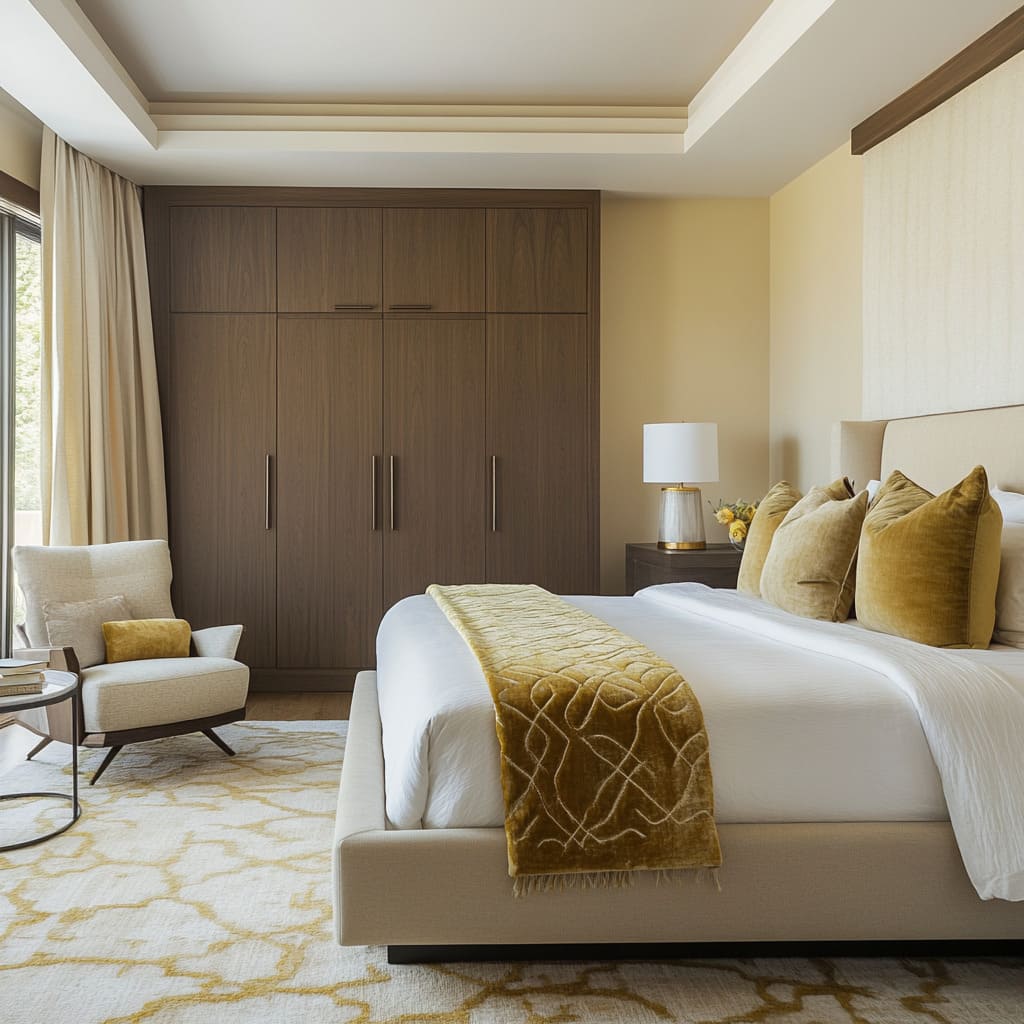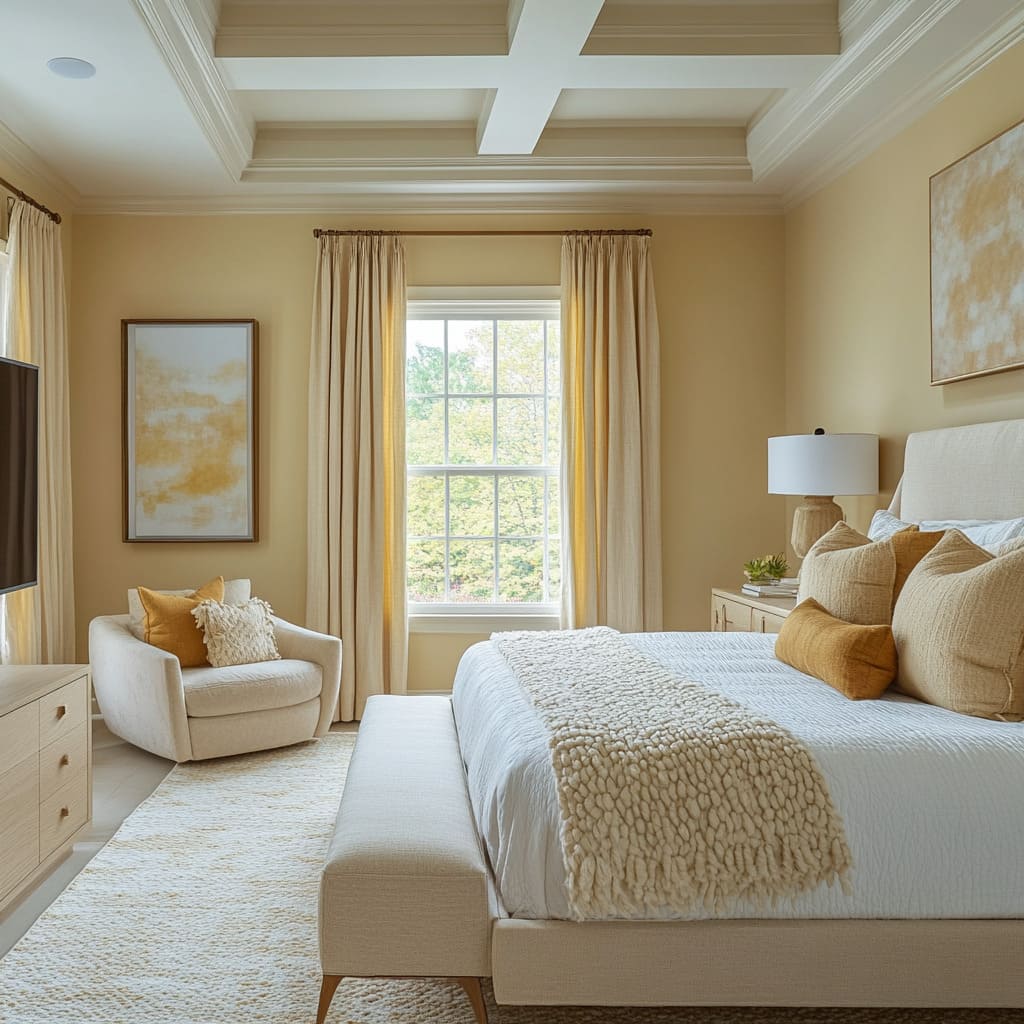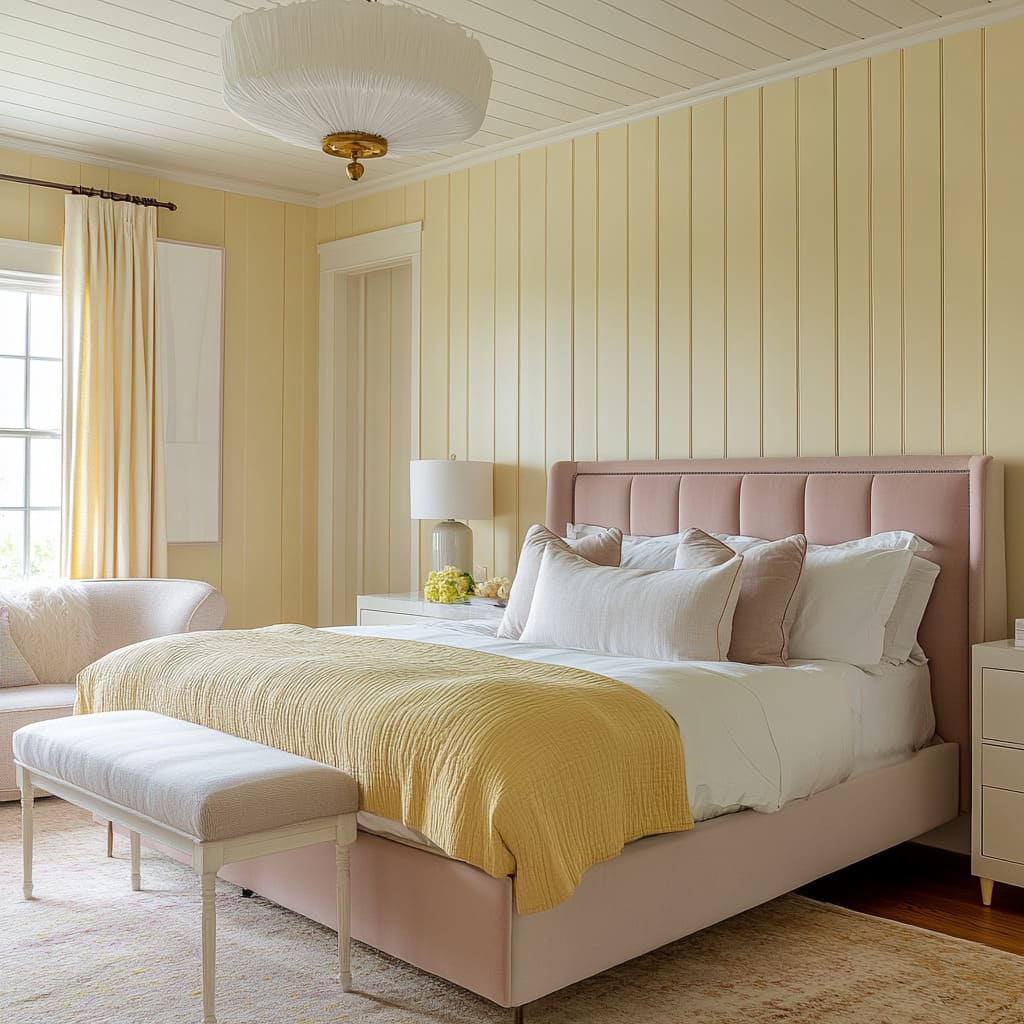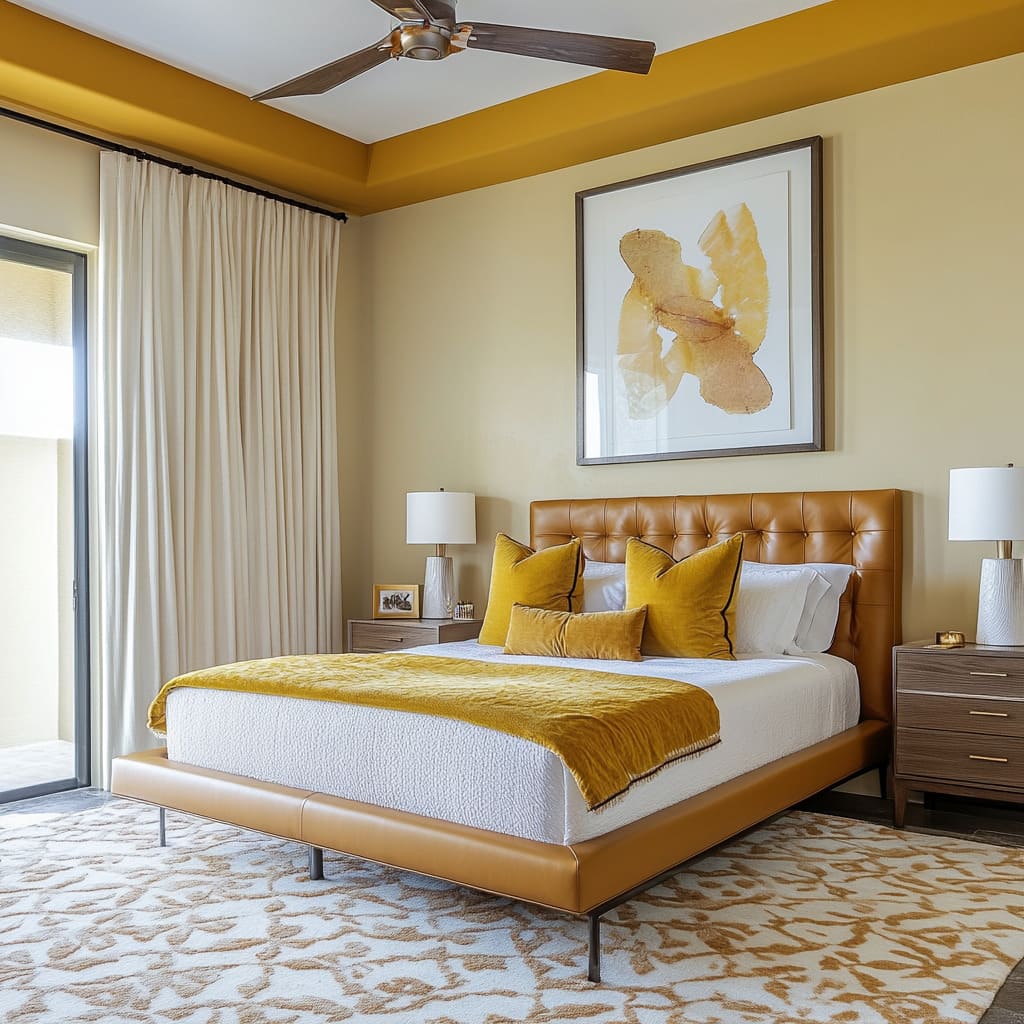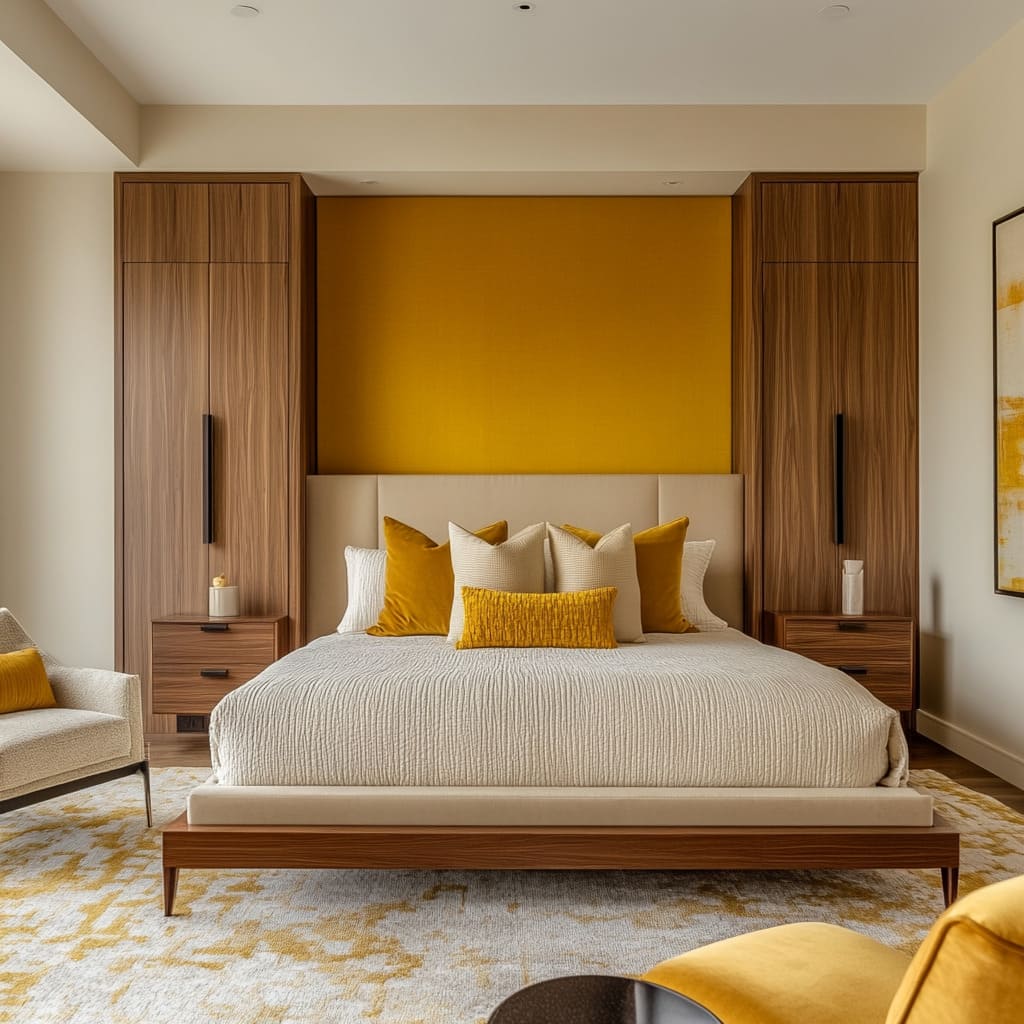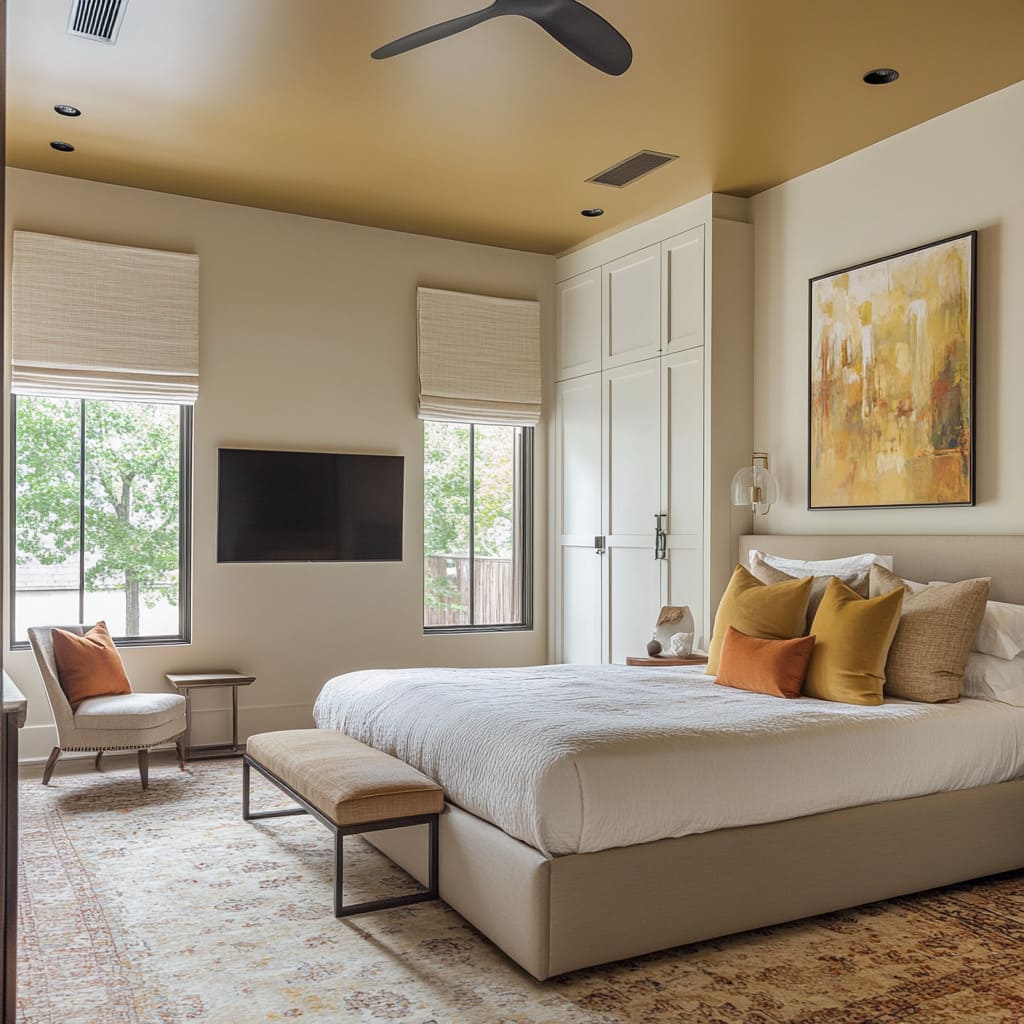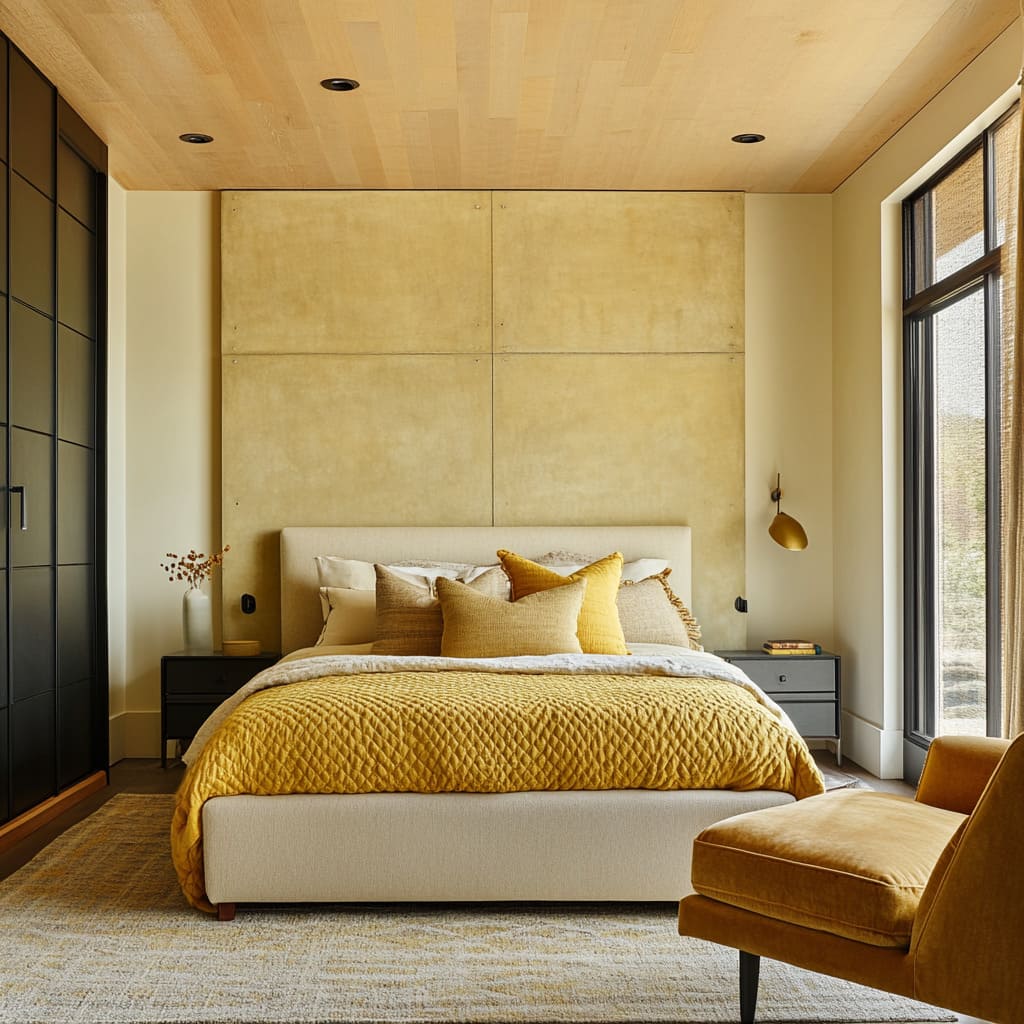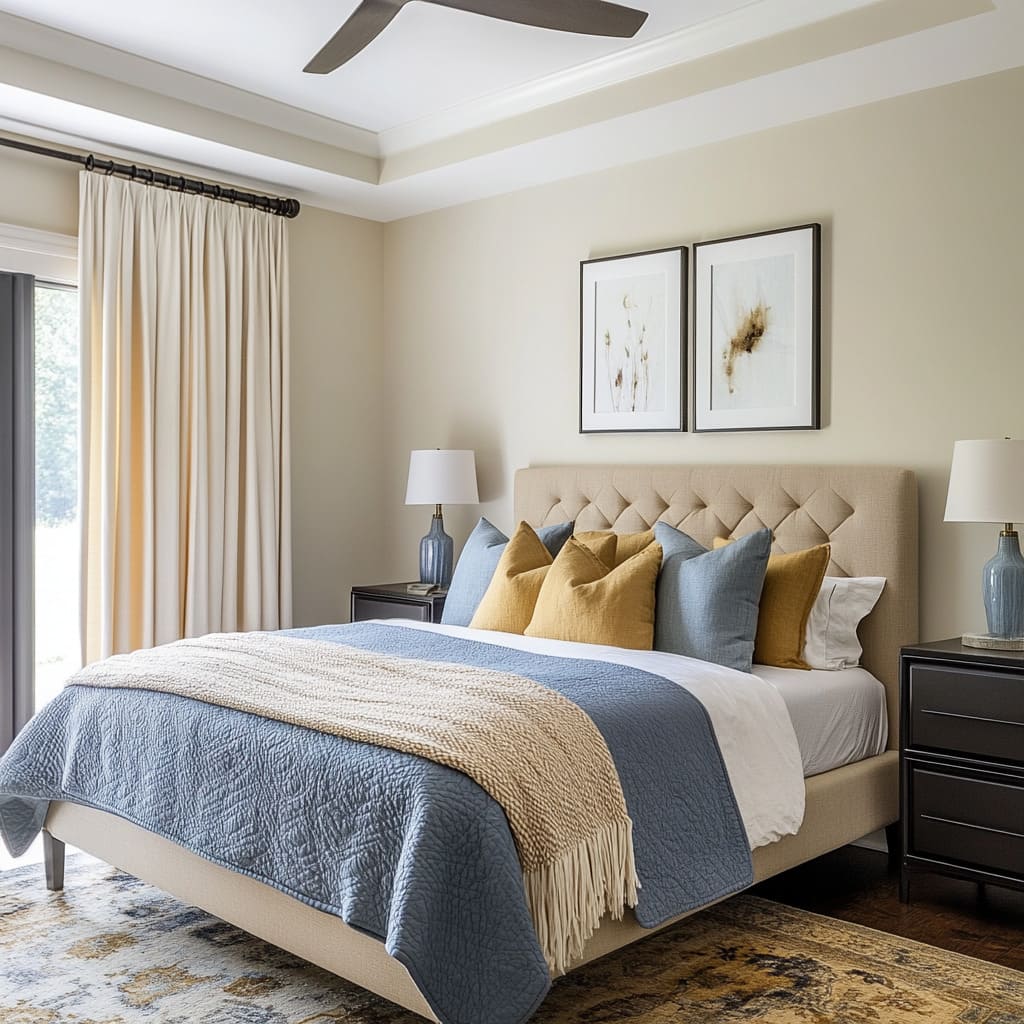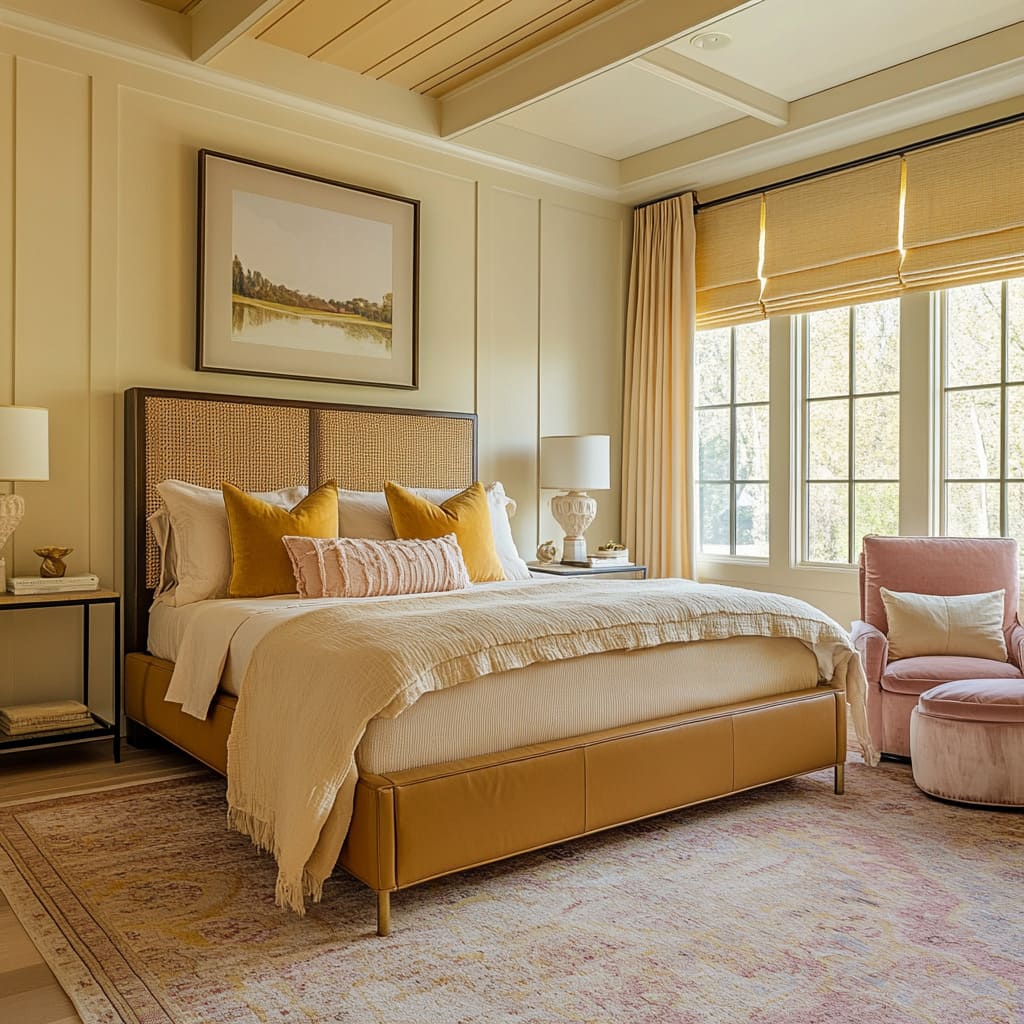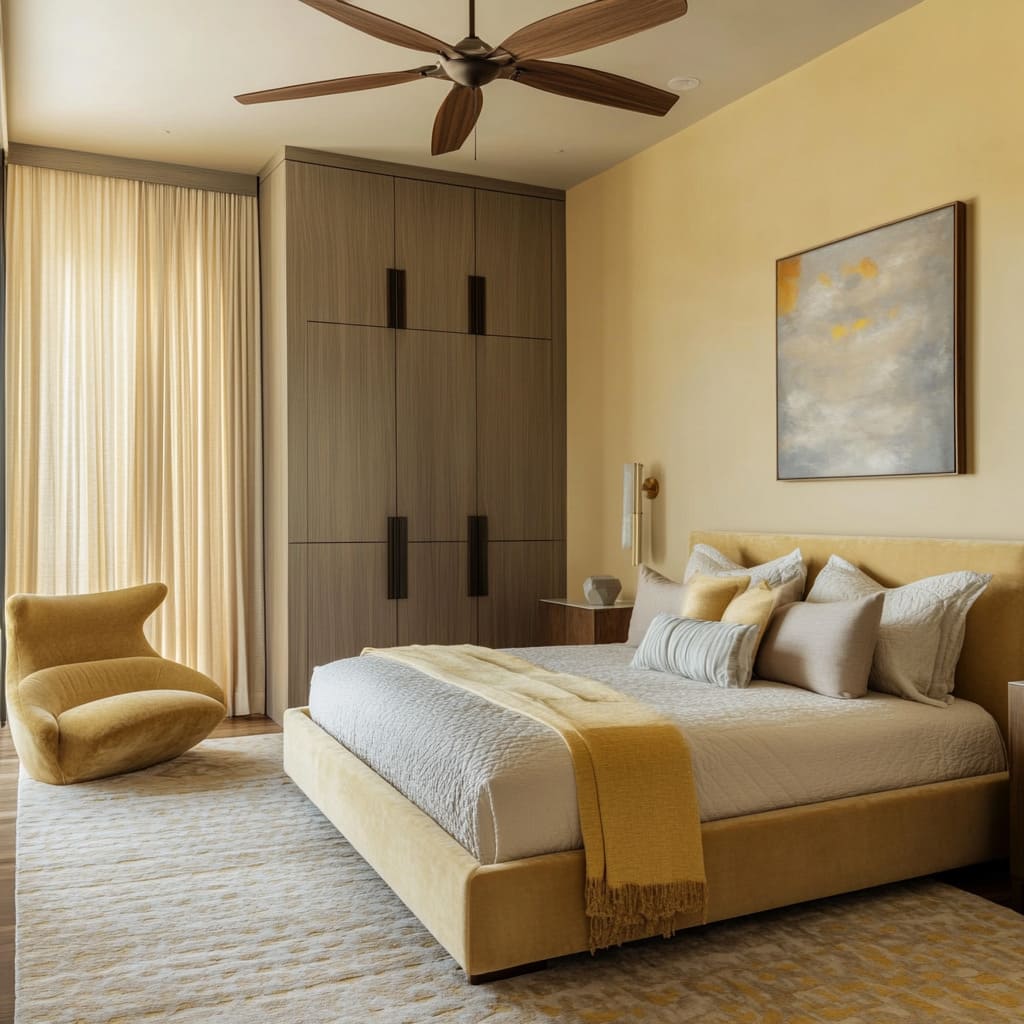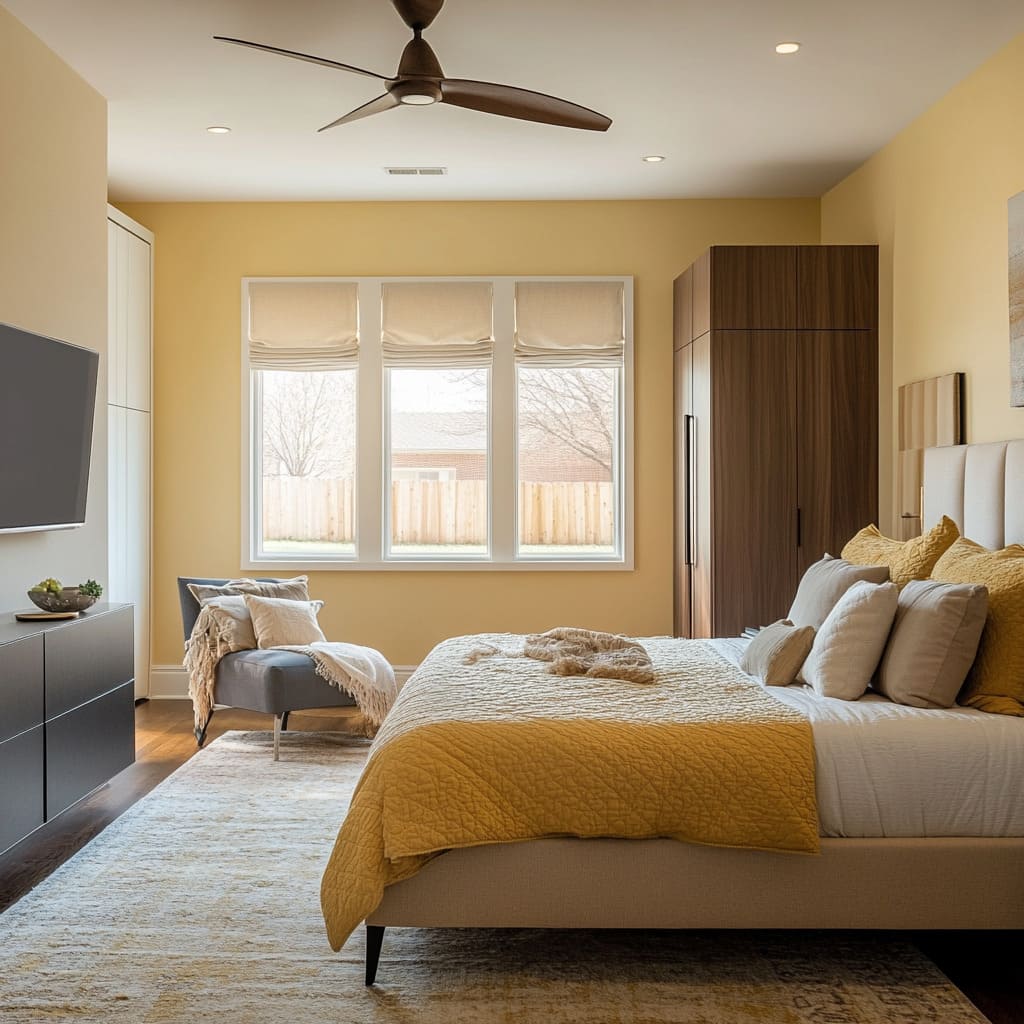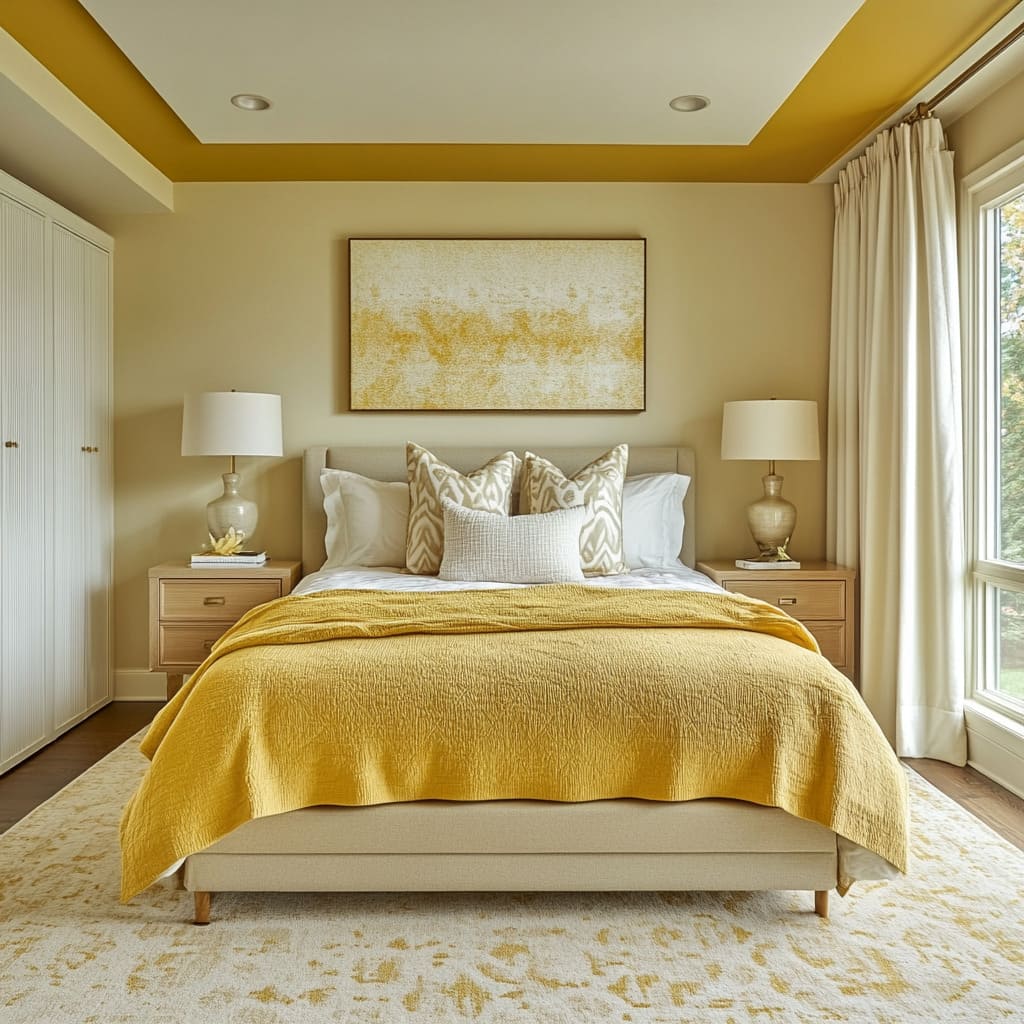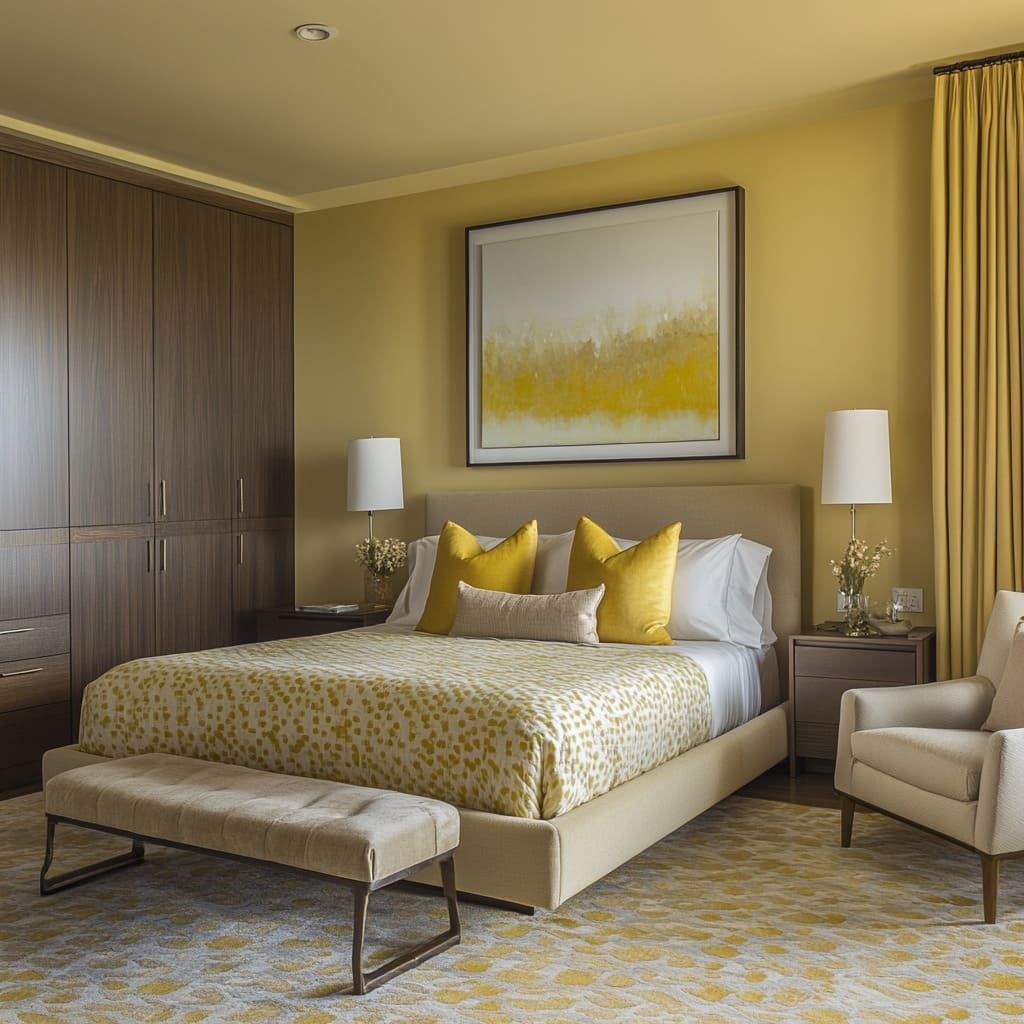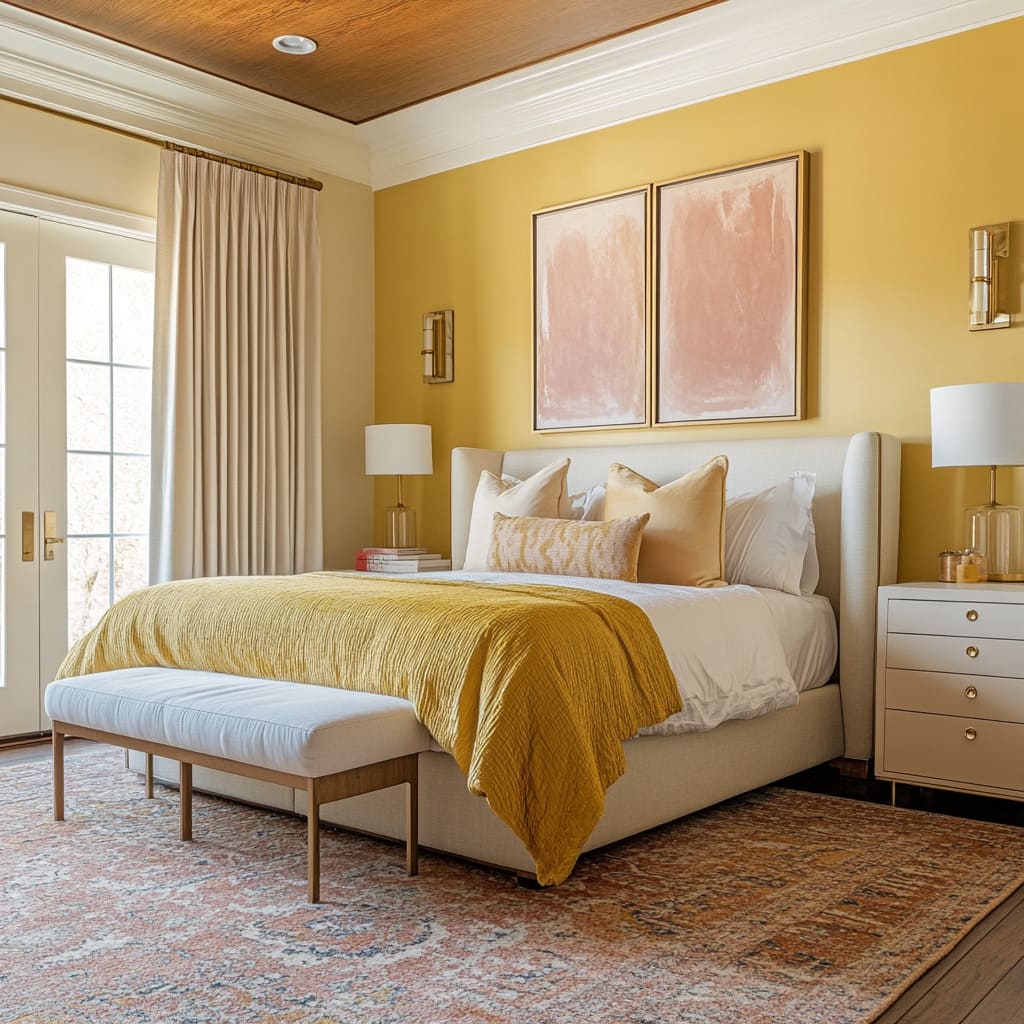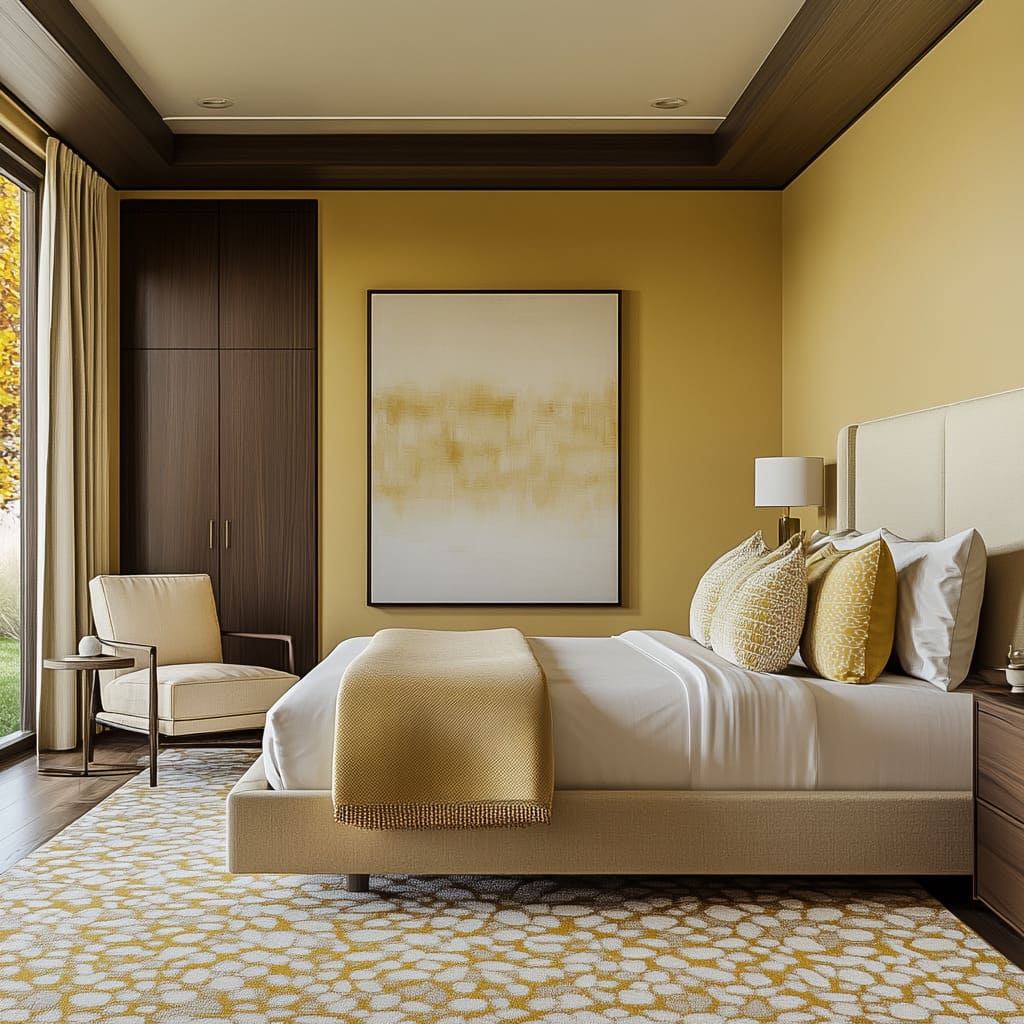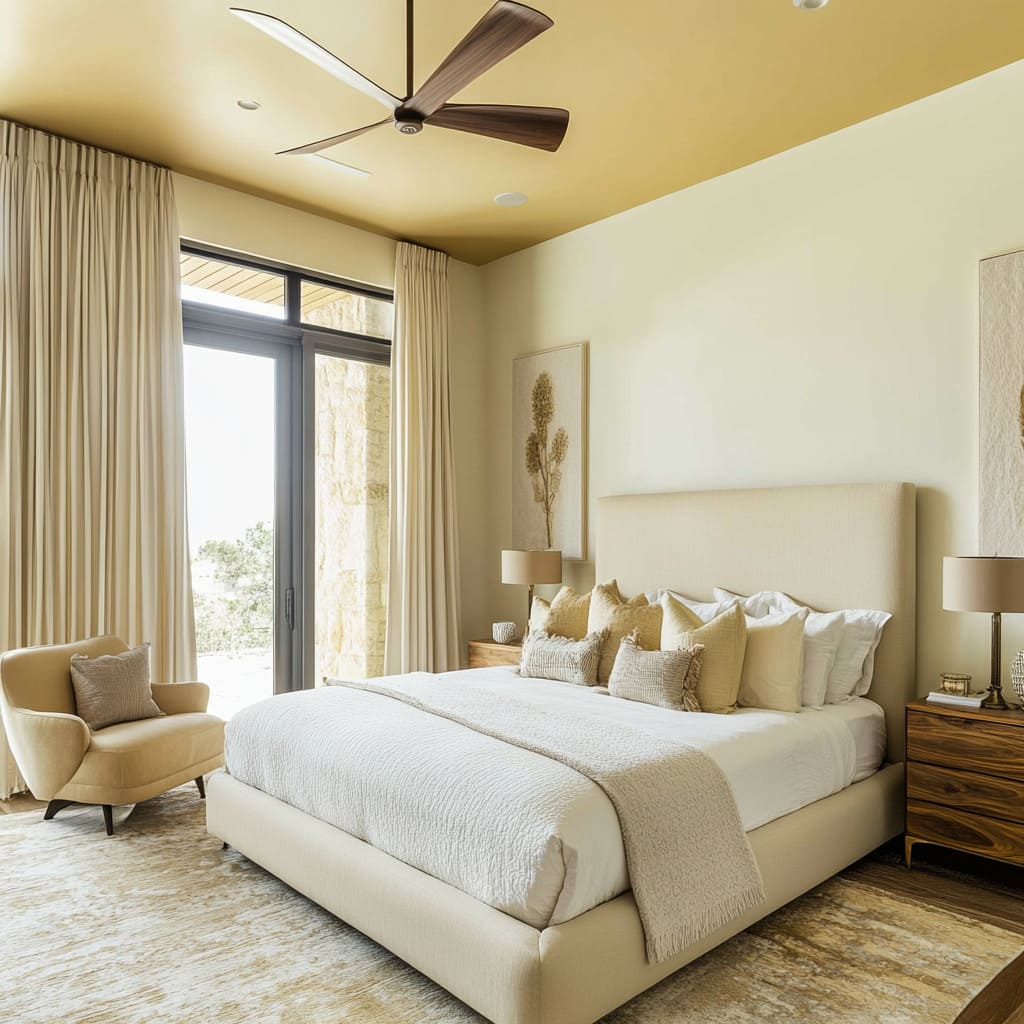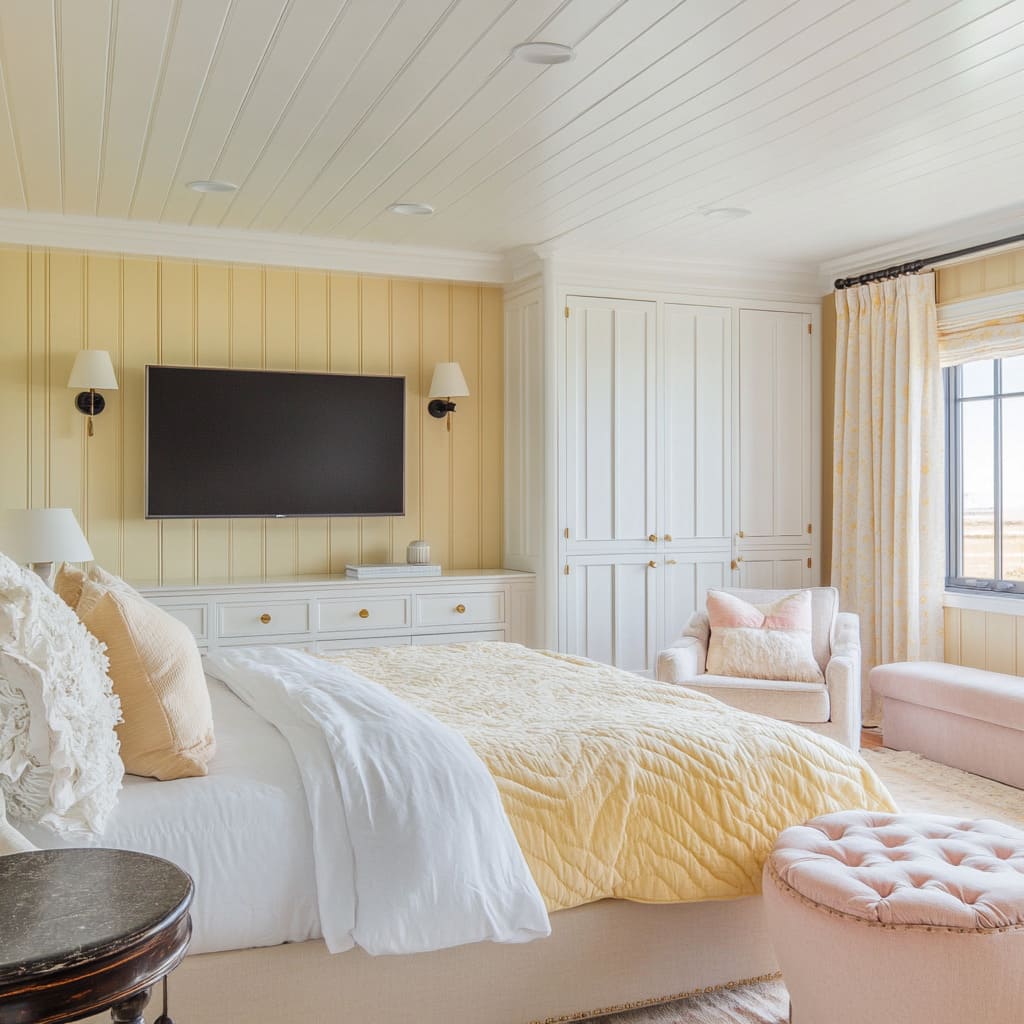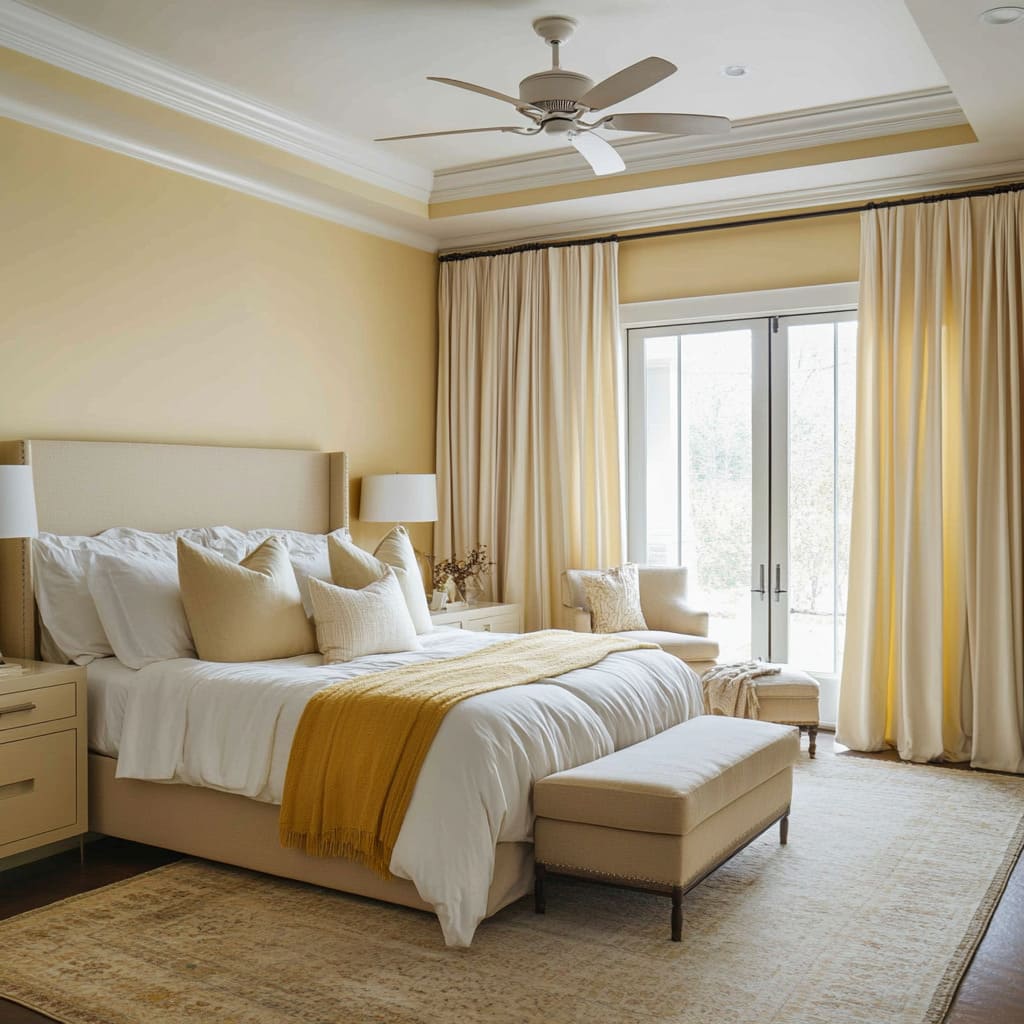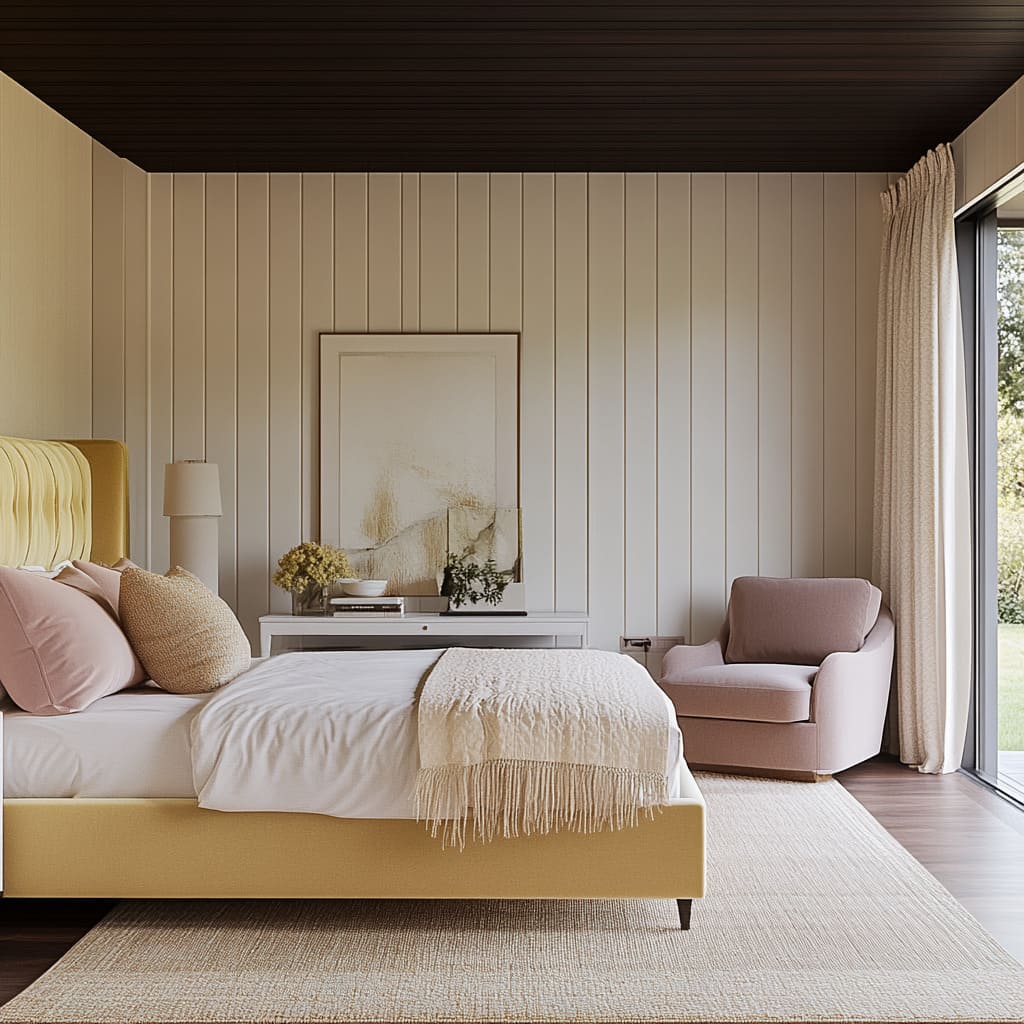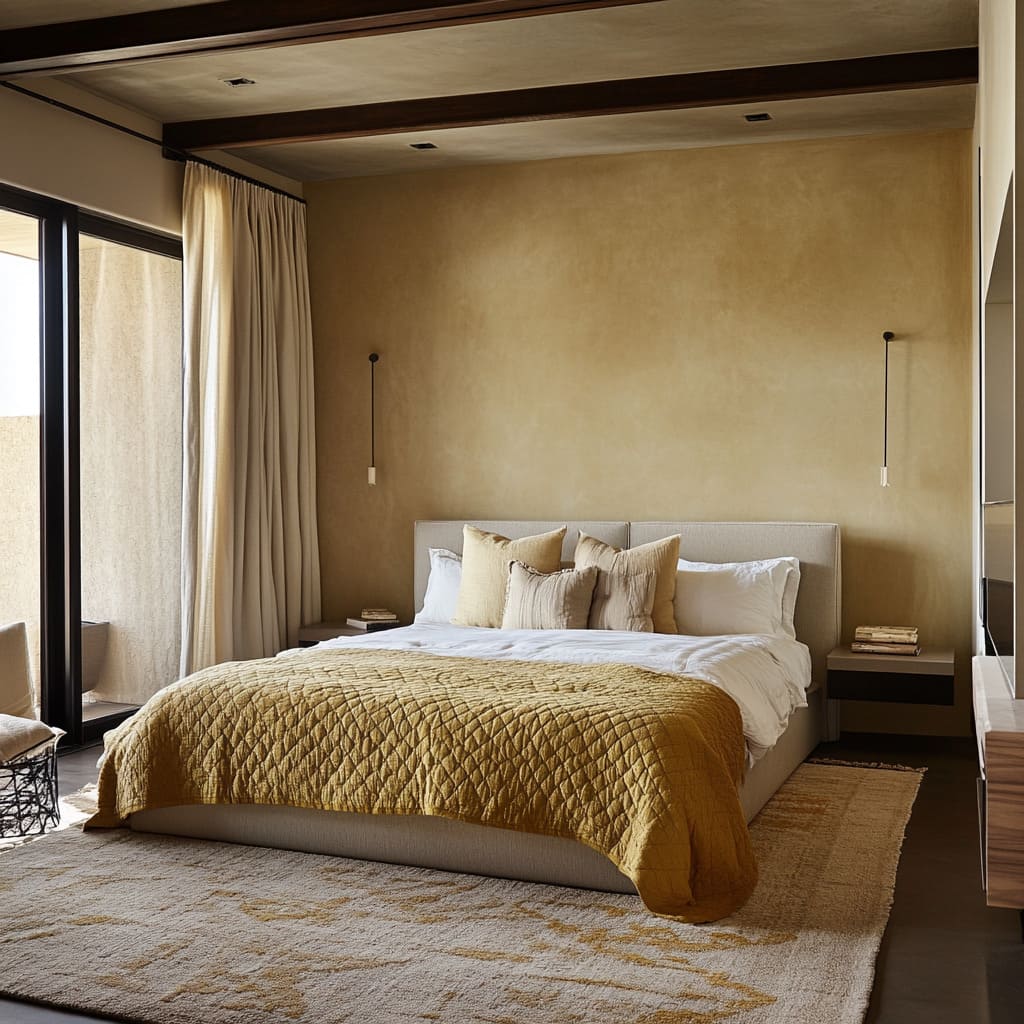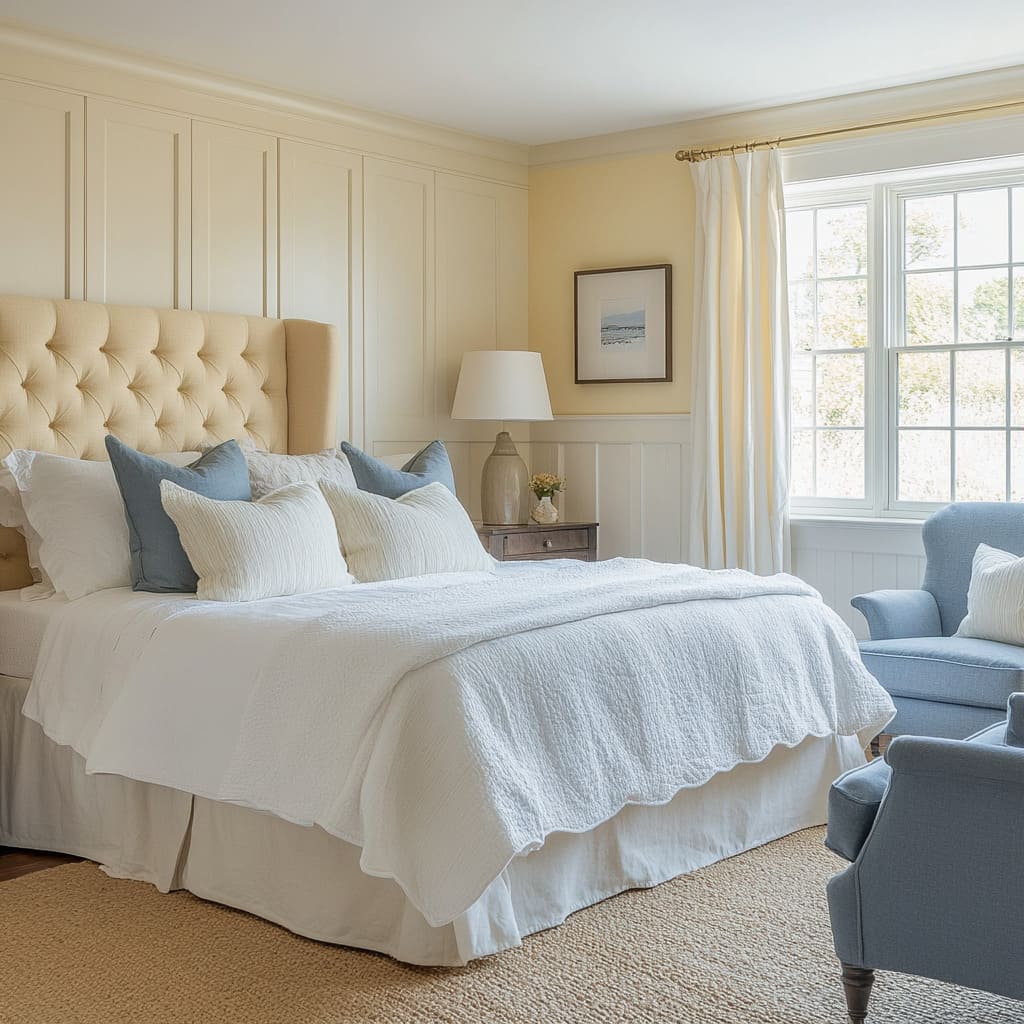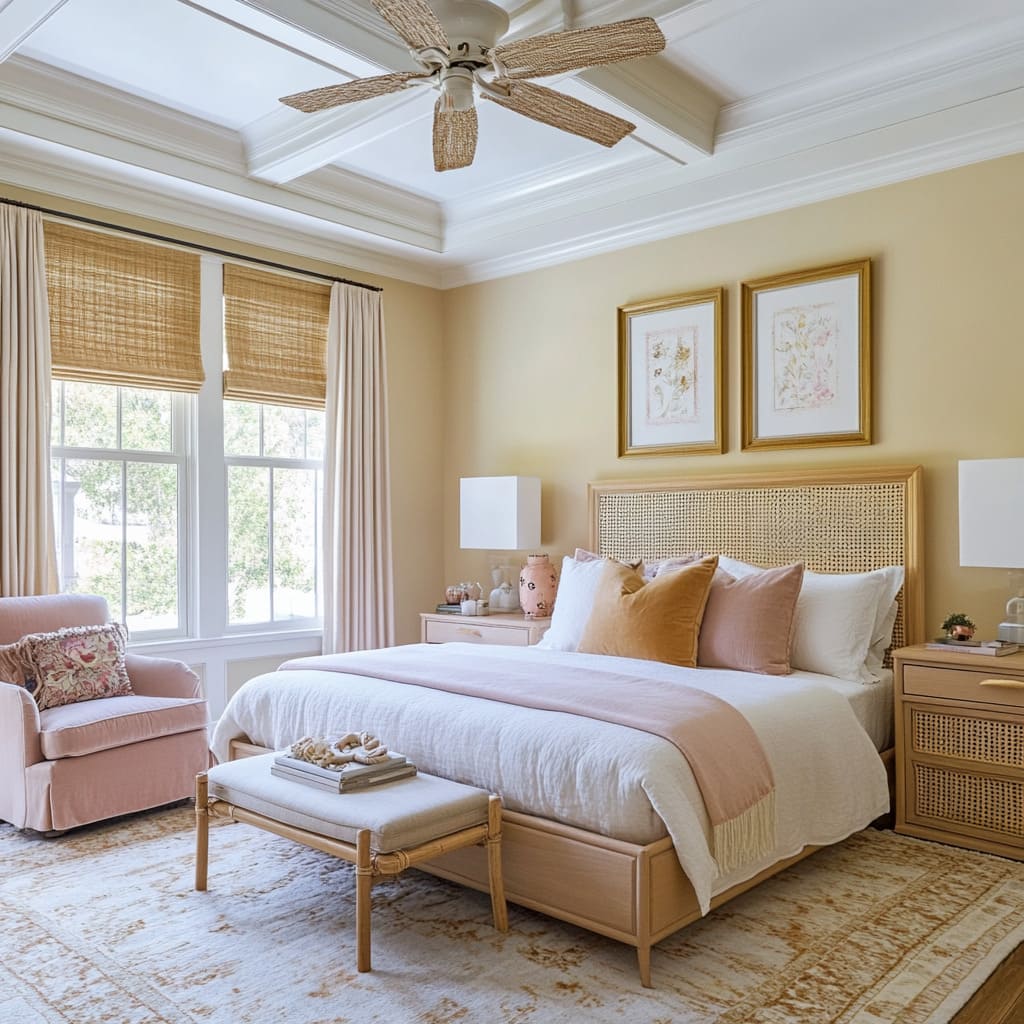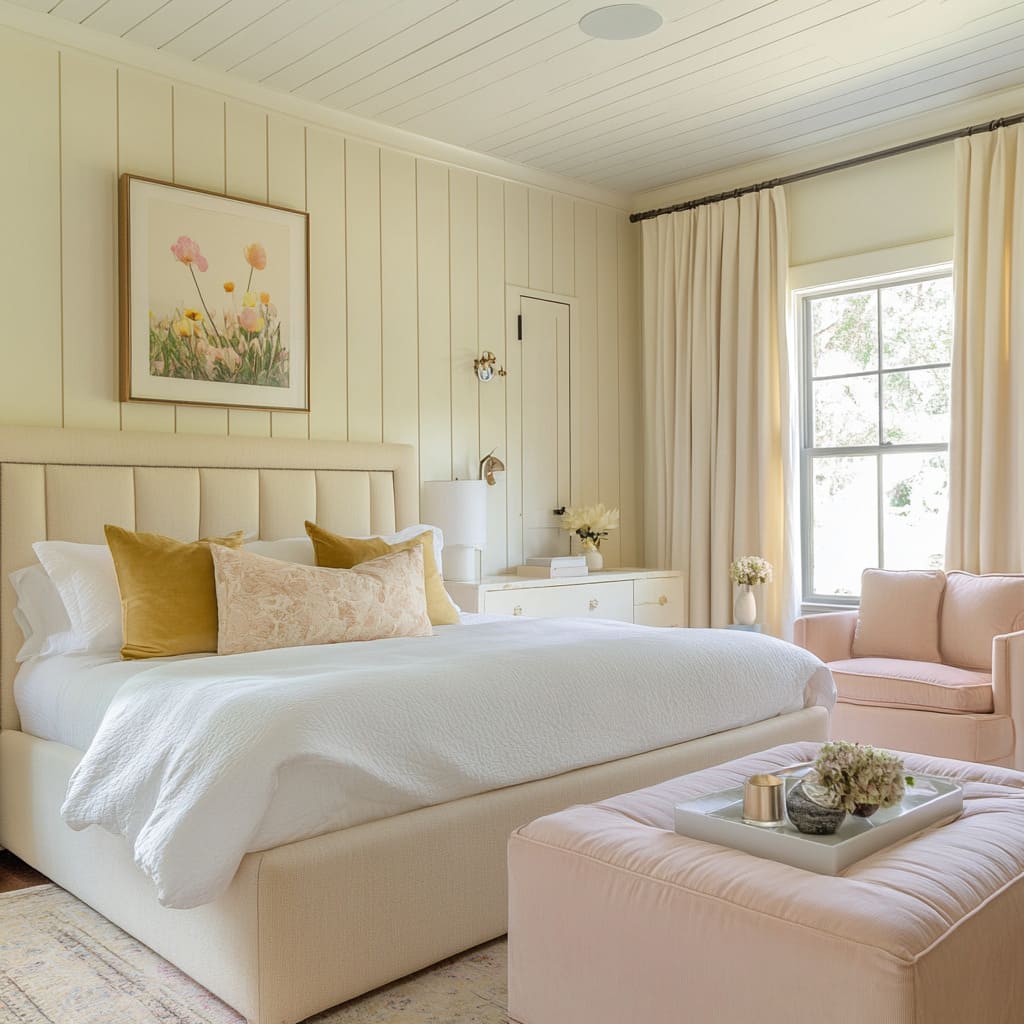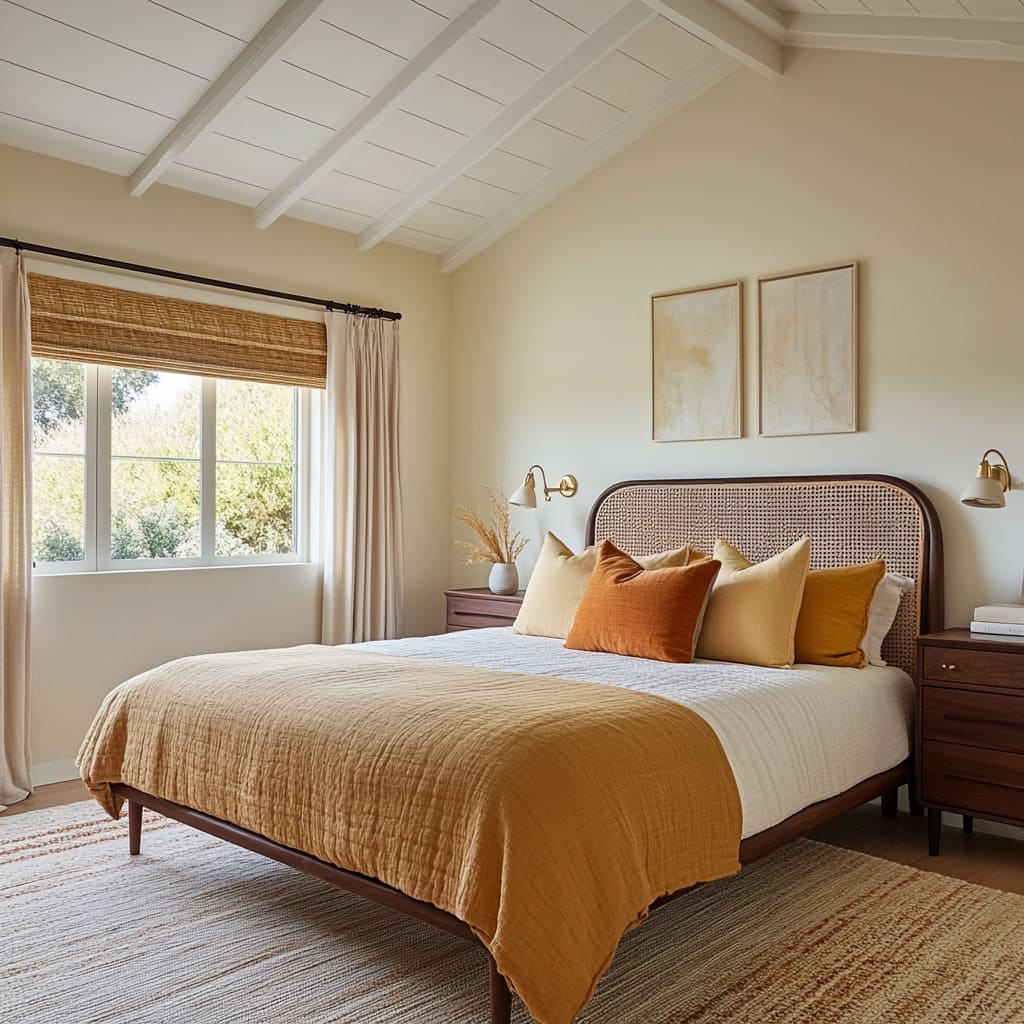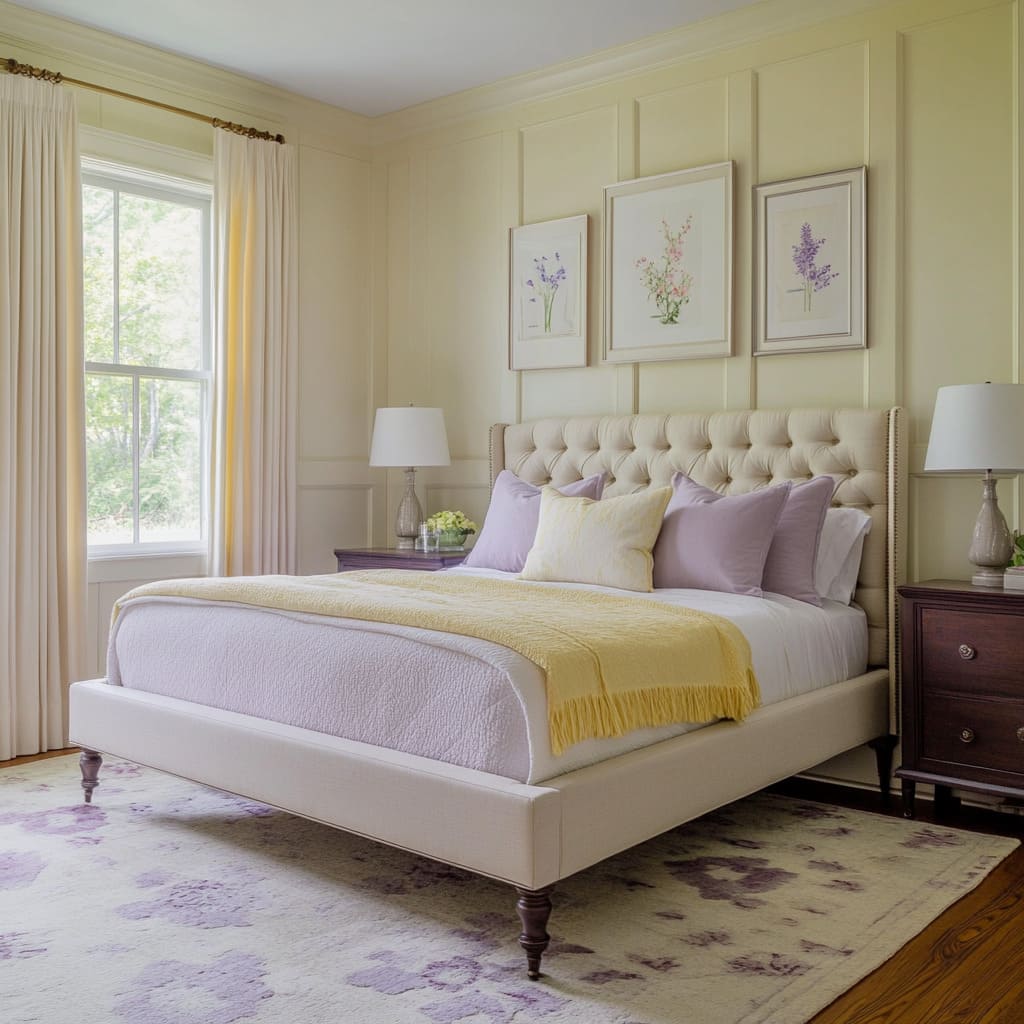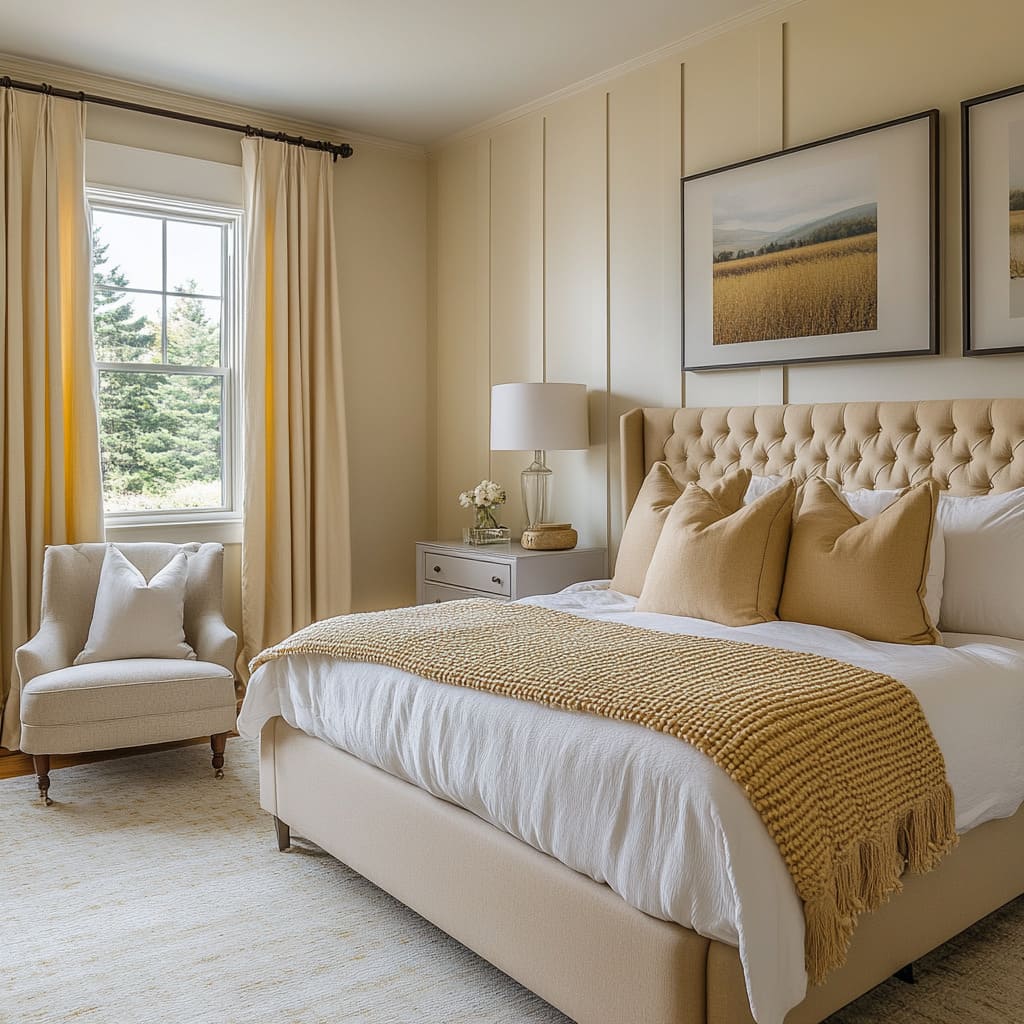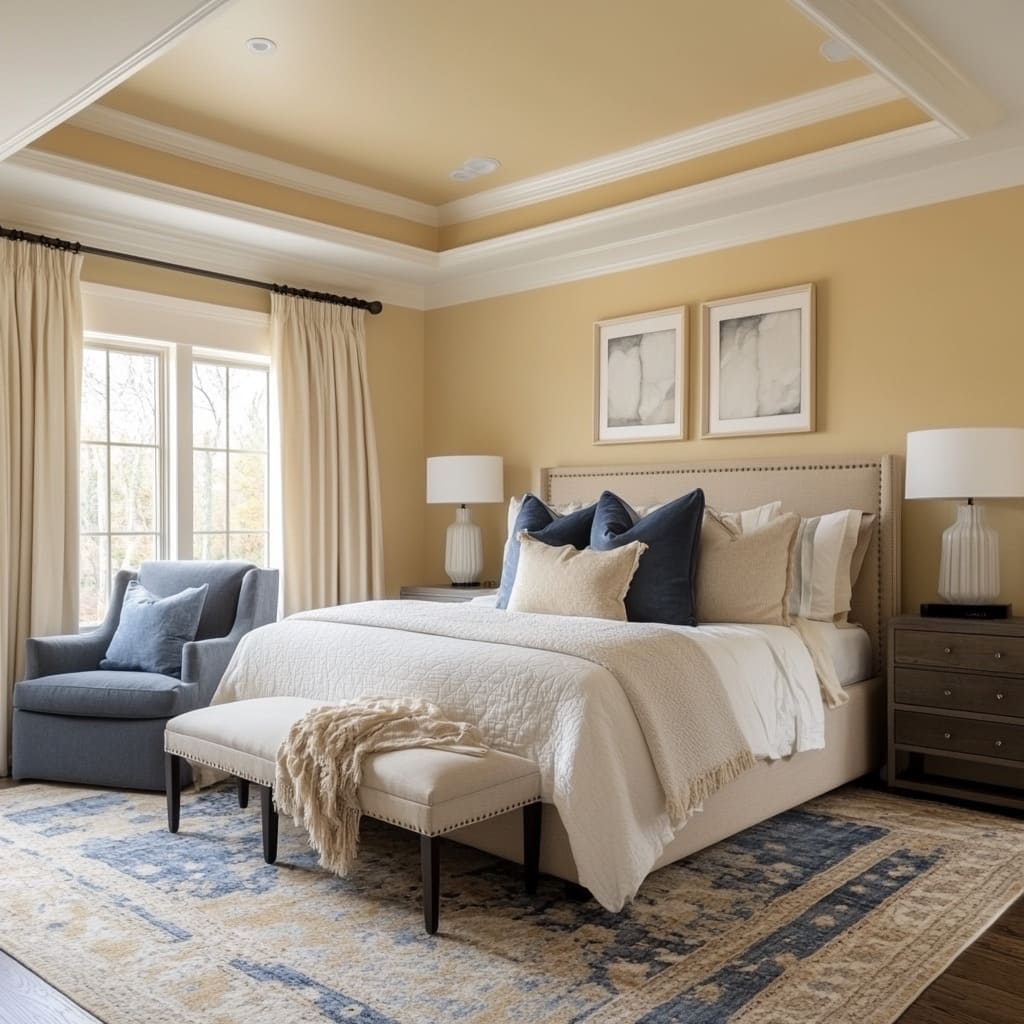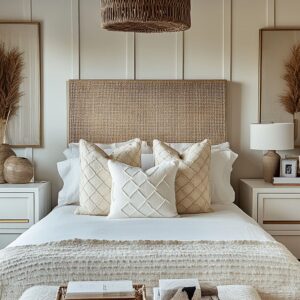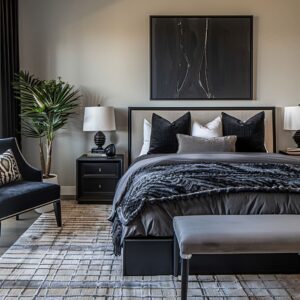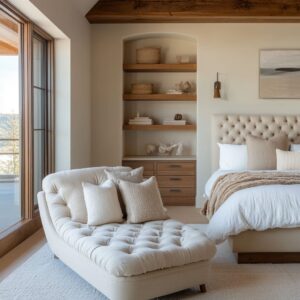Yellow has long been associated with warmth, optimism, and a sense of lightness, but its potential in bedroom design often gets overlooked. Many people hesitate to use yellow in a sleeping space, fearing it might be too overpowering or difficult to balance.
However, with thoughtful application, this color can create a stylish and inviting retreat, adding depth without overwhelming the senses. This article takes a closer look at how to incorporate yellow in ways that go beyond the obvious.
Instead of simply painting the walls or picking a bright bedspread, the focus is on layering different shades, textures, and architectural details to achieve a refined look. The best yellow bedroom design doesn’t rely on a single bold stroke—it comes together through subtle contrasts, unexpected placements, and an understanding of how light and material choices interact.
From understated golden undertones in paneling to deep ochre accent pieces, each approach in this guide highlights how to make yellow feel sophisticated rather than overpowering. Whether drawing inspiration from timeless interiors or modern styling, these ideas will help you shape a bedroom that feels balanced, stylish, and effortlessly inviting.
The Art of Subtlety: Layering Yellow for Depth and Balance
One of the biggest mistakes people make when incorporating yellow into a bedroom is treating it as a single-note color. The reality is, yellow has a vast range, from barely-there pastels to deep golden hues, and using multiple tones together can add complexity without overwhelming the space.
Whether you’re working with soft butter shades, warm ochre, or rich mustard, blending different versions of yellow allows for a layered and intentional look.
Layering Yellow in a Thoughtful Way
A common approach is to start with a softer shade as the foundation and introduce deeper accents through textiles and décor. Pale yellow walls or wainscoting can act as a warm backdrop, while ochre or burnt-gold elements—such as pillows, throws, or upholstered furniture—bring richness without overpowering the room.
This contrast creates movement in the design, making the space feel more dynamic. Another technique is to use gradation, allowing the eye to travel across the room through different depths of yellow.
A muted golden ceiling paired with warm-toned drapery or bedding ensures the color feels balanced rather than concentrated in one area. This approach works particularly well in spaces inspired by classic European interiors, where layered neutrals and warm hues naturally blend together.
Combining Multiple Yellows for a Natural Look
Using only one shade throughout a room can make the color feel flat, which is why mixing various tones is key. A great example of this can be seen in interiors that combine buttery walls with deep mustard textiles or golden-hued artwork.
This keeps the room from feeling too uniform while still maintaining a cohesive aesthetic. For those hesitant about using too much yellow, incorporating natural materials can help tone down the brightness.
Rattan furniture, raw linen curtains, and soft beige accents allow the warmth of yellow to shine through while keeping the overall look grounded. This method is particularly effective in spaces inspired by coastal or Scandinavian influences, where natural textures soften bold colors.
Why This Approach Works
Many people choose one shade of yellow and apply it throughout the space, but this often results in a room that feels either too intense or too underwhelming. By mixing two or three tones—whether through paint, fabrics, or décor—you create dimension and a more polished look.
This layering technique is especially useful in yellow bedroom ideas where the goal is to achieve warmth without overpowering the restful feel of the space. The secret to using yellow successfully isn’t about going all in on one bold choice—it’s about striking the right balance between soft, deep, and muted tones.
When done thoughtfully, the result is a bedroom that feels inviting, stylish, and full of quiet energy.
Beyond the Walls: Architectural Details That Elevate a Yellow Bedroom
Many people limit color placement to walls, missing out on how architectural details can completely shift the feel of a space. Instead of relying solely on painted walls to bring warmth, integrating yellow into ceilings, trim, or paneling introduces depth and character in a way that feels natural rather than overwhelming.
This approach is especially effective in adding personality to a room while maintaining a refined balance.
Ceilings That Create Atmosphere
Most ceilings are left white by default, but bringing yellow into this often-overlooked space can change the entire mood of a bedroom. A golden-toned ceiling, for example, creates a cocoon-like feel, making large rooms feel cozier and more inviting.
In spaces with high ceilings, a warm shade overhead helps visually lower the height, preventing the room from feeling too open or disconnected. In homes that embrace classic European influences, ceilings are often seen as a decorative element rather than an afterthought.
A muted yellow ceiling with intricate molding or coffered details can add depth without overpowering the rest of the design. In contrast, a sleek modern interior benefits from a seamless golden ceiling that adds warmth while keeping the lines clean.
The key is choosing a shade that enhances the overall atmosphere rather than competing with other elements in the room.
Paneling That Adds Texture and Refinement
Paneling is another way to incorporate yellow without resorting to fully painted walls. A soft yellow wainscoting or vertical paneling introduces warmth while allowing the upper walls to remain neutral.
This is a great option for those who love the idea of yellow but prefer a more understated application. Using paneling in this way also adds a layer of texture, making the room feel more structured.
This technique works particularly well in interiors inspired by coastal or countryside aesthetics, where painted wood detailing is a signature element. Even in more modern spaces, subtle paneling in a pale yellow tone can create a sense of depth without feeling overly traditional.
Another approach is painting trim, window frames, or crown molding in a warm yellow shade rather than stark white. This small change can create a subtle contrast while keeping the room light and airy.
It also helps frame the space, ensuring that the yellow bedroom theme feels intentional rather than overly concentrated in one area.
Why This Works So Well
The way color is distributed in a room matters just as much as the shade itself. Instead of relying on one large color block, breaking up yellow into ceilings, trim, or paneling introduces movement and balance.
This approach prevents the space from feeling flat while adding layers of warmth that feel inviting rather than overwhelming. By stepping away from the idea that color belongs only on walls, you open up new possibilities for making yellow feel natural, sophisticated, and perfectly suited for a bedroom retreat.
The Art of Contrast: Pairing Yellow with Complementary Hues
Yellow naturally brings warmth to a bedroom, but its impact becomes even more striking when paired with the right contrasting or complementary tones. Instead of defaulting to plain white or neutral gray, incorporating unexpected colors can make the design feel more layered and intentional.
Thoughtfully mixing shades can keep the space from looking overly bright while enhancing the richness of the yellow elements. How the 60-30-10 Rule Works in a Yellow Bedroom.
Soft Lavender and Blush for a Delicate Balance
A combination of pale yellow and lavender creates a refined, almost ethereal effect. This pairing works well because the gentle coolness of lavender softens the vibrancy of yellow, resulting in a room that feels balanced rather than overly warm.
This approach is especially effective in spaces with a vintage or romantic aesthetic, where soft pastels play a key role in the overall palette. A similar effect can be achieved by introducing blush pink accents.
A light mustard throw blanket paired with blush-colored pillows or drapery adds warmth without creating too much contrast. This pairing is commonly seen in European interiors, where muted pastels blend seamlessly with sunlit tones, making the space feel naturally inviting.
Deep Blues and Navy for a Bold Contrast
For a more dramatic look, rich navy or deep blue elements can create a striking contrast against yellow. Darker blues, particularly in textiles such as rugs, bedding, or upholstered furniture, help ground the space while allowing the yellow to stand out without overwhelming the room.
This combination has a timeless appeal, often found in classic coastal designs or sophisticated modern interiors. One way to incorporate this pairing is through accent furniture.
A navy blue velvet bench at the foot of the bed or a set of deep blue curtains framing a golden wall creates a structured, balanced design. The contrast between warm and cool tones keeps the space visually engaging while maintaining an overall sense of harmony.
Earthy Wood Tones for a Natural Connection
For those who prefer a more understated approach, blending yellow with natural wood finishes adds warmth in a way that feels effortless. Walnut nightstands, caramel leather headboards, or rattan furniture pieces complement yellow without making the room feel overly coordinated.
This works particularly well in spaces inspired by Scandinavian and Japandi aesthetics, where the emphasis is on natural materials and organic textures. The softness of warm-toned wood balances the energy of yellow, ensuring the space feels grounded rather than overly bright.
Why This Approach Works So Well
Instead of relying solely on neutrals, pairing yellow with strategic contrasts allows for more depth in the design. Whether it’s the delicate balance of lavender, the richness of deep blues, or the grounding effect of wood tones, these combinations make the space feel more polished and intentional.
By experimenting with these complementary shades, yellow bedroom decorating ideas become more refined, ensuring that the space remains stylish and inviting rather than overwhelming or one-dimensional. The key is to mix in colors that bring out the best in yellow while keeping the overall atmosphere balanced and thoughtfully arranged.
The Power of Texture: Elevating Yellow Through Layered Materials
Color alone isn’t enough to create a visually interesting space—it’s the combination of different textures that makes a bedroom feel inviting and rich in detail. When working with yellow, texture plays an even bigger role, as the right materials can either amplify its warmth or soften its vibrancy.
By mixing natural fibers, plush textiles, and metallic accents, the room gains dimension, preventing yellow from feeling too flat or overpowering.
Layering Fabrics for Depth and Comfort
Bedding is one of the easiest ways to introduce texture, and combining different materials can instantly enhance the space. A crisp white quilt provides a neutral base, but adding a golden-hued throw or a patterned coverlet creates movement and variation.
Choosing fabrics with distinct textures—such as a chunky knit blanket, smooth linen sheets, and velvet pillows—ensures the room feels both cozy and stylish. Patterns also play a role in making yellow feel more dynamic.
A subtly printed duvet cover with ochre or mustard tones brings visual interest without overwhelming the design. If a full bedspread feels like too much, layering in smaller elements—like a woven lumbar pillow or a soft cashmere throw—can introduce color without committing to an all-yellow scheme.
This approach is especially useful for those experimenting with yellow bedding ideas, as it allows for easy seasonal updates.
Natural Materials That Enhance Yellow’s Warmth
Yellow pairs beautifully with organic textures, which help ground the color and make the space feel more balanced. A rattan or cane headboard adds an earthy contrast to soft bedding, while a woven jute rug underfoot enhances the warmth of the overall palette.
Even small details—like a wicker basket for extra blankets or linen curtains that diffuse natural light—bring a tactile quality that makes the room feel layered rather than one-dimensional. Wood finishes also work particularly well with yellow.
Lighter tones like oak or maple create a bright, airy look, while deeper shades like walnut or mahogany provide contrast and sophistication. Nightstands or dressers with a slightly weathered finish can add a touch of character, making the space feel more lived-in and inviting.
Metallic Accents for a Refined Touch
Brass, gold, or antique bronze details can reinforce the warmth of yellow without overwhelming the space with more color. Instead of relying solely on bold yellow elements, subtle metallic accents—such as drawer pulls, lamp bases, or picture frames—add depth and a hint of elegance.
A mirror with a brushed gold frame or a set of wall sconces in an aged brass finish can bring a sense of balance, ensuring that the yellow tones in the room feel purposeful rather than overly dominant. Even a small side table with a metallic base can introduce an extra layer of contrast, keeping the design visually interesting.
Why Texture Makes a Difference
Yellow is a naturally bold color, but when paired with textured materials, it becomes softer and more versatile. The interplay of rough and smooth surfaces, matte and shiny finishes, and light and dark contrasts allows the space to feel curated rather than one-note.
By thoughtfully incorporating different fabrics, natural elements, and subtle metallics, yellow becomes more than just a color choice—it becomes part of a carefully layered and inviting bedroom design.
Lighting and Yellow: Creating the Right Atmosphere
Lighting has the power to transform any bedroom, but when working with yellow, it becomes even more essential. The way this color interacts with natural and artificial light can dramatically change how it appears throughout the day.
A shade that feels soft and airy in the morning can take on a richer, golden glow in the evening, depending on placement and intensity of light sources. Understanding how to adjust lighting ensures that yellow enhances the space rather than overpowering it.
How Natural Light Affects Yellow
Yellow responds differently to sunlight based on the time of day and the direction the room faces. A soft buttery shade may appear fresh and bright in the morning when east-facing windows bring in cool daylight, while in the late afternoon, the same hue can shift into a deeper golden tone as warm sunlight filters through west-facing windows.
Positioning mirrors strategically helps reflect this natural shift, spreading light evenly across the room while preventing shadows from making yellow tones feel too intense in certain areas. In smaller spaces, placing a mirror opposite a window maximizes brightness, ensuring the room never feels dim or overly saturated.
For rooms with limited natural light, sheer curtains in a warm ivory or pale gold allow sunlight to filter through softly, creating a gentle glow that blends seamlessly with yellow elements rather than creating harsh contrasts.
Artificial Light and Its Impact on Yellow
Artificial lighting plays an equally important role in shaping the feel of a yellow bedroom. The type of bulb, its placement, and even the finish of lamp bases can either enhance the warmth of yellow or cause unwanted color shifts.
- Choosing the Right Bulbs: Warm white or soft amber bulbs work best in a yellow bedroom, as they highlight golden undertones without creating a harsh glare. Cool-toned LED bulbs, on the other hand, can make yellow appear slightly greenish, dulling its warmth.
- Lamps That Enhance Yellow: Brass, aged gold, or ceramic lamp bases in complementary tones act like secondary light reflectors, subtly amplifying the warmth of the room. Table lamps with fabric shades in cream or light beige diffuse light in a way that makes yellow feel softer and more inviting.
- Wall Sconces for a Cozy Glow: Mounted sconces with warm bulbs provide an indirect glow, preventing overhead lighting from washing out yellow tones. These work particularly well in bedrooms with layered textures, as they highlight depth without overpowering softer elements.
Ceiling Treatments That Amplify the Glow
In spaces where yellow extends to the ceiling, lighting choices become even more crucial. A ceiling painted in a golden hue naturally reflects warm light, creating a gentle radiance throughout the room.
In these cases, recessed lighting or pendant fixtures with diffused covers can prevent any single light source from casting shadows that make the space feel unevenly lit. During winter or in dimly lit rooms, adding a layered lighting approach—combining bedside lamps, sconces, and soft ambient lighting—keeps the space feeling warm rather than overly bright.
This is especially useful in homes that incorporate yellow bedroom design ideas inspired by cozy, welcoming interiors.
Why Lighting Choice Matters
Many people focus on paint swatches or décor when designing with yellow, but lighting ultimately determines whether the color feels inviting or overwhelming. By adjusting natural and artificial light sources, the same yellow tone can take on multiple moods, from soft and airy in daylight to warm and cozy at night.
Small tweaks, like using warm bulbs, reflective surfaces, or layered lighting, can make all the difference in shaping the perfect atmosphere.
Patterns and Prints: Enhancing Yellow Without Overpowering
Yellow makes a strong statement in any bedroom, but how it’s paired with patterns can determine whether the space feels stylish and layered or overwhelming. The right mix of prints, textures, and motifs adds movement and interest, keeping the room visually dynamic without letting a single shade dominate.
Instead of playing it safe with solid colors, introducing thoughtful patterns can break up the intensity of yellow and make the design feel more intentional.
Rugs That Tie the Room Together
A well-chosen rug is one of the easiest ways to incorporate pattern while reinforcing the overall color scheme. A design that includes subtle gold or mustard details helps blend the flooring into the rest of the space, creating a seamless transition between surfaces.
Geometric patterns with clean lines can make a modern bedroom feel more structured, while swirling or organic designs add a sense of softness, preventing yellow from feeling too rigid. For those hesitant to introduce more color, a neutral rug with muted golden tones can complement the room without drawing too much attention to itself.
Artwork That Adds a Subtle Layer
Wall art plays a major role in setting the tone of a bedroom, and in a space that already incorporates yellow, it’s best to avoid overly matchy pieces. Instead of choosing artwork that directly replicates the wall color, abstract prints with warm, blended tones create depth without overwhelming the space.
A piece with soft beige, rust, or even hints of blue can help balance yellow elements while introducing contrast. For a more eclectic look, mixing different frame styles—such as antique gold and matte black—can add variety without making the artwork feel disconnected from the rest of the room.
This approach works well in spaces with a mix of traditional and modern influences, allowing for an organic, curated feel.
Bedding That Introduces Playful Contrast
Bedding is another place where pattern can make an impact. While solid-colored linens provide a calming effect, incorporating a few patterned elements—like a decorative pillow or a quilt with subtle prints—adds another layer of detail.
Geometric prints, especially in mustard or deep ochre tones, work well in contemporary spaces, while floral motifs or delicate stripes bring a softer, more classic feel. The key is balance: a patterned duvet or pillow should add to the room’s visual rhythm without competing with other elements like the walls or curtains.
Why Thoughtful Pattern Choices Matter
A bedroom with yellow as the main color needs structure to keep the space feeling polished rather than overwhelming. That’s where prints and patterns come in—they create movement and variation, guiding the eye without making any single feature feel too dominant.
By using yellow bedroom color ideas in combination with complementary patterns, the space feels more layered and engaging. Whether through rugs, artwork, or textiles, the right mix of prints ensures that yellow remains a striking element while still blending harmoniously into the rest of the design.
Yellow in the Details: Adding Subtle Accents for a Cohesive Look
A yellow-themed bedroom doesn’t have to rely on large painted surfaces or statement furniture to make an impact. Sometimes, the most stylish and thoughtfully designed spaces distribute color in ways that aren’t immediately obvious.
Small, unexpected touches of yellow can bring the room together, ensuring that the palette feels natural rather than overpowering. The key is to think beyond walls and bedding, integrating warm hues into architectural elements, fixtures, and decorative accents.
Window Treatments That Soften the Look
One of the easiest ways to incorporate yellow without overwhelming the space is through window treatments. Pale gold curtains, woven straw-toned blinds, or even a linen Roman shade with subtle golden embroidery can introduce warmth without making the room feel too saturated.
Layering sheer drapery with heavier fabric panels allows for flexibility—during the day, soft sunlight filters through, giving the room a natural golden glow, while in the evening, thicker curtains can provide a cozier feel. This technique works particularly well in bedrooms inspired by Mediterranean or rustic aesthetics, where warm tones and natural textures complement each other beautifully.
Ceiling Fans and Light Fixtures That Echo the Palette
In modern spaces, ceiling fans are often overlooked as a design element, but they offer an opportunity to reinforce color in a subtle way. A wood-toned or brass-accented fan blends effortlessly with yellow tones, adding warmth without feeling like an intentional color statement.
Similarly, pendant lights or sconces with aged brass or matte gold finishes can create a soft glow that enhances the golden tones in the room. These small but impactful choices prevent the space from feeling too one-dimensional while reinforcing the overall warmth of the palette.
Cabinetry and Built-In Details That Add Depth
For bedrooms with built-in wardrobes, bookshelves, or storage cabinets, hardware and finishes provide another way to integrate yellow without using paint. Brass or gold drawer pulls, antique-inspired knobs, or even a subtle mustard-hued accent inside open shelving can create a sense of cohesion.
In some interiors, custom cabinetry with a warm cream or taupe finish paired with golden hardware achieves a refined balance—keeping the room light and neutral while still nodding to the overall color scheme. This approach works particularly well in spaces that lean toward transitional or European-inspired design, where understated elegance plays a key role.
Why These Details Matter
Rather than relying solely on large, bold applications of yellow, these unexpected placements create a layered effect that makes the space feel more intentional. By weaving in warm hues through textiles, fixtures, and built-ins, the room develops a sense of flow, ensuring that no single element feels disconnected.
Incorporating yellow bedroom color ideas in subtle ways allows for a more sophisticated approach, where the warmth of the color is felt throughout the space rather than concentrated in one area. These small choices add up, shaping a bedroom that feels balanced, stylish, and thoughtfully put together.
Keeping Yellow Balanced: How to Avoid Overload
Yellow has an undeniable warmth that can instantly brighten a bedroom, but without the right balancing elements, it can become overwhelming. The key to making yellow feel refined rather than overpowering is contrast—introducing deeper tones, neutral foundations, and subtle natural elements that ground the space.
By carefully choosing complementary shades and materials, the result is a space that feels both inviting and effortlessly composed.
Deep and Dark Tones That Provide Contrast
A room filled with strong yellow tones needs grounding elements to avoid feeling too pastel-heavy or overly cheerful. Dark-stained furniture, such as a walnut nightstand or a deep espresso dresser, creates an anchor that keeps the space from feeling too light and airy.
Black accents, particularly in window frames, picture frames, or sleek lighting fixtures, provide definition without competing with the warmth of yellow. Even a charcoal-hued chair or a deep brown woven basket can introduce just enough depth to create a sense of balance.
This approach is often found in modern or industrial-influenced interiors, where strong contrasts make colors feel intentional rather than overpowering.
Soft Whites and Creams That Tone Down Brightness
One of the most effective ways to temper the intensity of yellow is by surrounding it with soft, neutral hues. Creamy white walls, an off-white area rug, or even simple white ceiling beams create a clean backdrop that allows yellow accents to shine without feeling excessive.
A bed dressed in neutral layers—such as an ivory duvet cover with warm beige throw pillows—can soften even the most golden-toned walls. The idea is to create a layered effect where yellow is complemented rather than competing with the surrounding colors.
This method is particularly common in Mediterranean and Scandinavian-inspired interiors, where warm tones blend seamlessly with natural light and muted textures.
Greenery That Connects the Palette to Nature
Introducing natural elements is another way to keep yellow from feeling too saturated. Houseplants, whether large leafy greens or small succulents, provide a visual break from the intensity of yellow while reinforcing a fresh, organic feel.
For those who prefer something more subtle, a floral arrangement with soft yellow blooms mixed with greenery can create a natural transition between warm and cool tones. This method works especially well in bedrooms inspired by French country or vintage aesthetics, where fresh florals are often part of the décor.
Why Balance Matters
The key to working with yellow successfully is ensuring it doesn’t take over the space. A thoughtfully balanced bedroom keeps the warmth of yellow intact while preventing it from feeling too intense over time.
Darker accents, soft neutrals, and touches of nature all work together to create a bedroom that feels stylish, livable, and easy on the eyes.
Mixing Old and New: Creating Depth with Traditional and Modern Elements
One of the most effective ways to make a yellow-themed bedroom feel fresh and layered is by blending classic and modern design elements. Yellow naturally adapts to a wide range of styles—from rustic and vintage-inspired to sleek and contemporary—so incorporating details from different eras keeps the space visually engaging.
Instead of committing entirely to one aesthetic, combining structured, time-honored pieces with more streamlined accents creates contrast and personality.
Classic Architecture with Modern Accessories
A bedroom with traditional elements, such as wainscoting, crown molding, or paneled walls, can instantly feel updated by pairing it with modern lighting, bold artwork, or sculptural furniture. A tufted headboard in a soft neutral fabric can set a timeless foundation, but introducing sleek metal sconces or abstract prints above the bed ensures the room doesn’t feel overly traditional.
Brass or matte black fixtures work particularly well in these settings, as they offer a sharp contrast against the softness of yellow walls or upholstery. This approach is commonly seen in European-inspired interiors, where historic architectural details meet contemporary styling for a refined yet eclectic look.
Minimalist Beds with Vintage Textiles
If the room leans more modern—with a clean-lined bed frame, minimalist furniture, or an open layout—layering in vintage or antique-style textiles can create a richer, more lived-in feel. A simple platform bed can be warmed up with an aged Persian rug featuring golden undertones, or a mustard-hued quilt with subtle embroidery can add texture without making the space feel too ornate.
This balance between streamlined and decorative elements prevents the room from feeling too stark or too embellished. It’s a technique often used in Scandinavian and Japandi interiors, where understated furniture is softened with heirloom-inspired fabrics and carefully selected accents.
Why This Contrast Works So Well
Pairing traditional and modern elements allows yellow to shine without feeling locked into a single style category. By mixing structured architecture with contemporary shapes or combining sleek furniture with classic textiles, the space remains flexible and visually layered.
This method also ensures longevity—while trends come and go, a room with varied influences feels more curated and less tied to any one era. The contrast between old and new keeps the space from feeling too predictable, making it a dynamic and interesting place to unwind.
Finding the Right Balance: Managing Yellow in Proportion
Yellow can bring warmth and personality to a bedroom, but using too much of it—or applying it without balance—can make the space feel overwhelming. A structured approach ensures that yellow enhances the design rather than overpowering it.
One of the most effective ways to achieve this balance is by following the 60-30-10 rule, a well-known guideline in interior design that helps distribute colors harmoniously.
How the 60-30-10 Rule Works in a Yellow Bedroom
60%: The Foundation
The main color of the room should be a soft, neutral shade that creates a calming backdrop. This could be a light cream, soft beige, warm white, or even a subtle taupe.
Applying this tone to the walls, large furniture pieces, or flooring ensures that the room maintains an airy, relaxed atmosphere while giving yellow the space to stand out.
30%: The Supporting Role
This is where yellow takes center stage. The trick is to distribute it in a way that feels intentional without overwhelming the senses.
This could mean:.
- A golden-hued accent wall.
- Mustard or ochre-colored bedding, throws, or curtains.
- A bold upholstered headboard.
- Statement furniture pieces, such as a yellow bench or armchair.
By keeping yellow within this proportion, it remains a key feature while still working in harmony with the rest of the space.
10%: The Unexpected Touch
The final layer is where contrast and interest come into play. A small percentage of an accent color—such as navy, lavender, rust, or even muted green—prevents the room from feeling too one-note.
This can be added through:.
- Decorative pillows.
- A patterned area rug with hints of yellow and a secondary color.
- Artwork that blends warm and cool tones.
- Metallic or wood accents, such as brass lighting fixtures or walnut nightstands.
This element keeps the design dynamic, ensuring that yellow feels refined rather than overly dominant.
Why This Approach Works
The 60-30-10 formula prevents a bedroom from feeling visually overwhelming, creating a natural flow between colors. It also makes it easier to adjust the design over time—if the yellow elements ever feel too strong, shifting the 30% balance to different accents (like swapping out bedding or furniture) can refresh the look without a full redesign.
By applying this structure, a yellow-themed bedroom remains balanced, stylish, and effortlessly inviting.
Final Thoughts: Crafting a Balanced Yellow Bedroom
Incorporating yellow into a bedroom goes far beyond choosing a paint color. It’s about layering tones, working with texture, and carefully balancing complementary hues to create a space that feels intentional and inviting.
When applied thoughtfully, yellow can serve as a grounding element rather than an overpowering feature, allowing the room to feel warm, stylish, and adaptable. Instead of defaulting to fully saturated walls, consider softer applications—a painted ceiling, subtle wainscoting, or built-in details that introduce warmth without overwhelming the space.
Textiles also play a crucial role; mixing linen, velvet, or woven materials can add richness and prevent the color from feeling flat.
Lighting is another major factor. The way natural and artificial light interact with yellow can shift the mood of the room throughout the day.
Thoughtfully placed lamps, sconces, or reflective surfaces can enhance this effect, making the space feel brighter and more dimensional. Even the smallest details matter—golden-hued drawer pulls, a warm brass light fixture, or artwork that subtly incorporates warm tones can all reinforce the color palette without making the design feel overly coordinated.
By blending these strategies, a yellow bedroom can feel nuanced and welcoming. Whether the goal is a bold statement or a more understated warmth, the key is balance—allowing yellow to be a unifying thread rather than the dominant force.

